*For each bridge, the annual probability of collision with a ship greater than 150 meters is estimated. The reciprocal of this estimated collision probability is reported as the return period.
Details of the calculations involved in estimating the annual probability of collision can be found here.
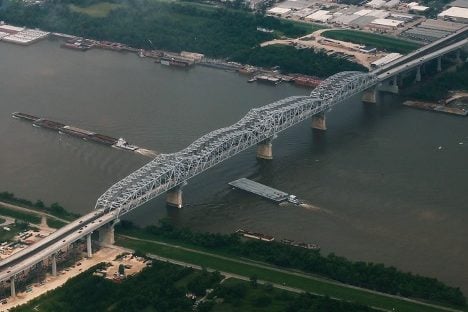
1
Huey P. Long Bridge (LA)
Estimated Return Period of Collision: 17 years
Estimated Annual Probability of Collision: 5.8%
Read More
The Huey P. Long Bridge spans the Mississippi River just north of New Orleans. It was completed in 1935 and originally carried two railroad tracks and four traffic lanes, but was widened in 2013 to carry one additional lane of traffic in each direction. Over the river, the superstructure includes four steel truss spans with a cantilevered central span. There are three shipping channels under the bridge, with the majority of traffic using the span bounded by the middle and south piers. The piers – originally simple reinforced concrete column bents – had to be retrofitted to accommodate the 2013 widening, and now are topped off with a steel frame to support the widened deck structure. The pier dimensions do not include the foundations visible at the water line. Piers are equipped with fenders.
The bridge sees an average of 18-19 large ships per day, which ranks 4th nationally in large ship traffic. Traffic is primarily from ships with lengths less than 250m, although several much larger ships pass through annually.
The bridge is expected to experience a major ship collision approximately once every 17 years.
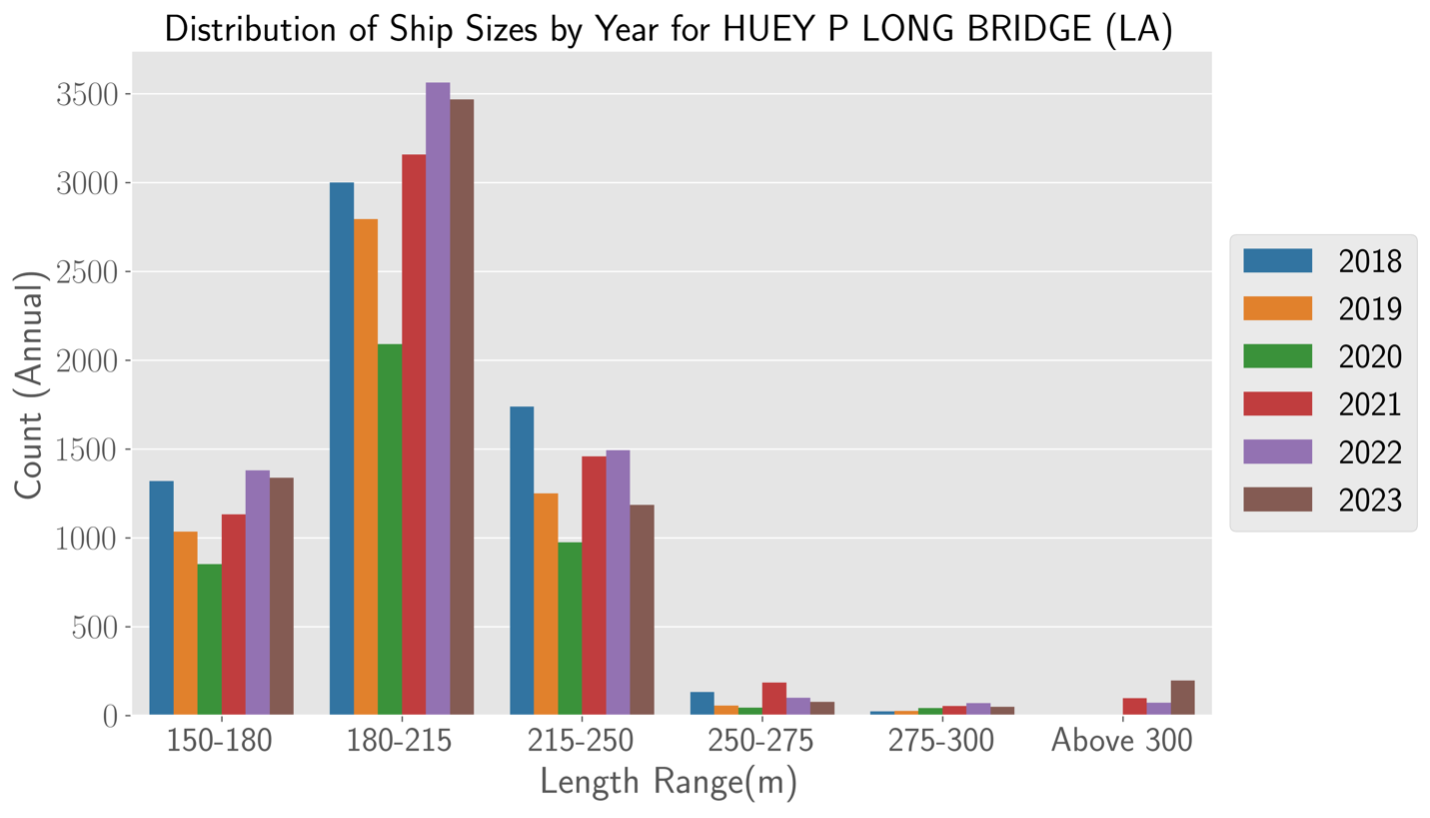
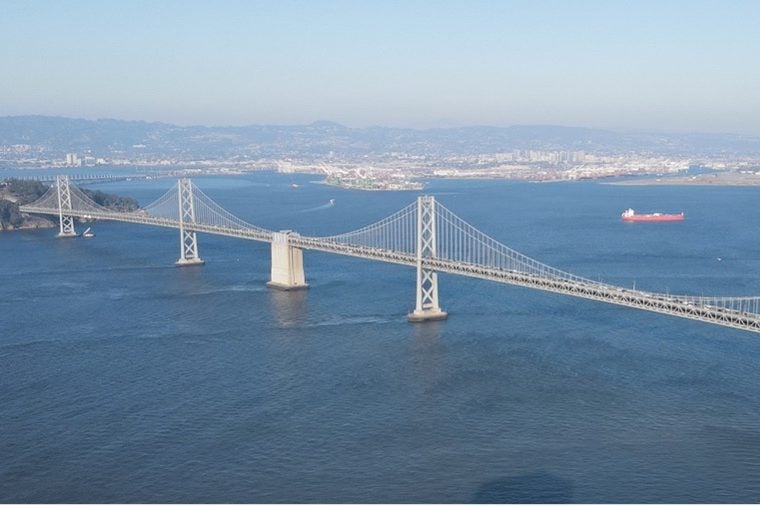
2
San Francisco – Oakland Bay Bridge (CA)
Estimated Return Period of Collision: 22 years
Estimated Annual Probability of Collision: 4.6%
Read More
The San Francisco – Oakland Bay Bridge in this case refers to the western-most spans that carry I-80 between San Francisco and Yerba Buena Island. Completed in 1936, the bridge is a suspension form with steel towers constructed on caissons. The pier dimensions for the geometry calculations were taken as only the steel tower footprint above the foundation and not the out-to-out dimensions of the foundation showing above the water line. The foundations are protected by fenders. The bridge has four spans where large ship traffic passes although the majority passes under the span between the two northern piers, while the other spans see less traffic.
The bridge sees and average of 10-11 large ships per day, which ranks 9th nationally in large ship traffic. Traffic is varied in size with a mixture of large and extremely large ship traffic.
The bridge is expected to experience a major ship collision approximately once every 22 years.
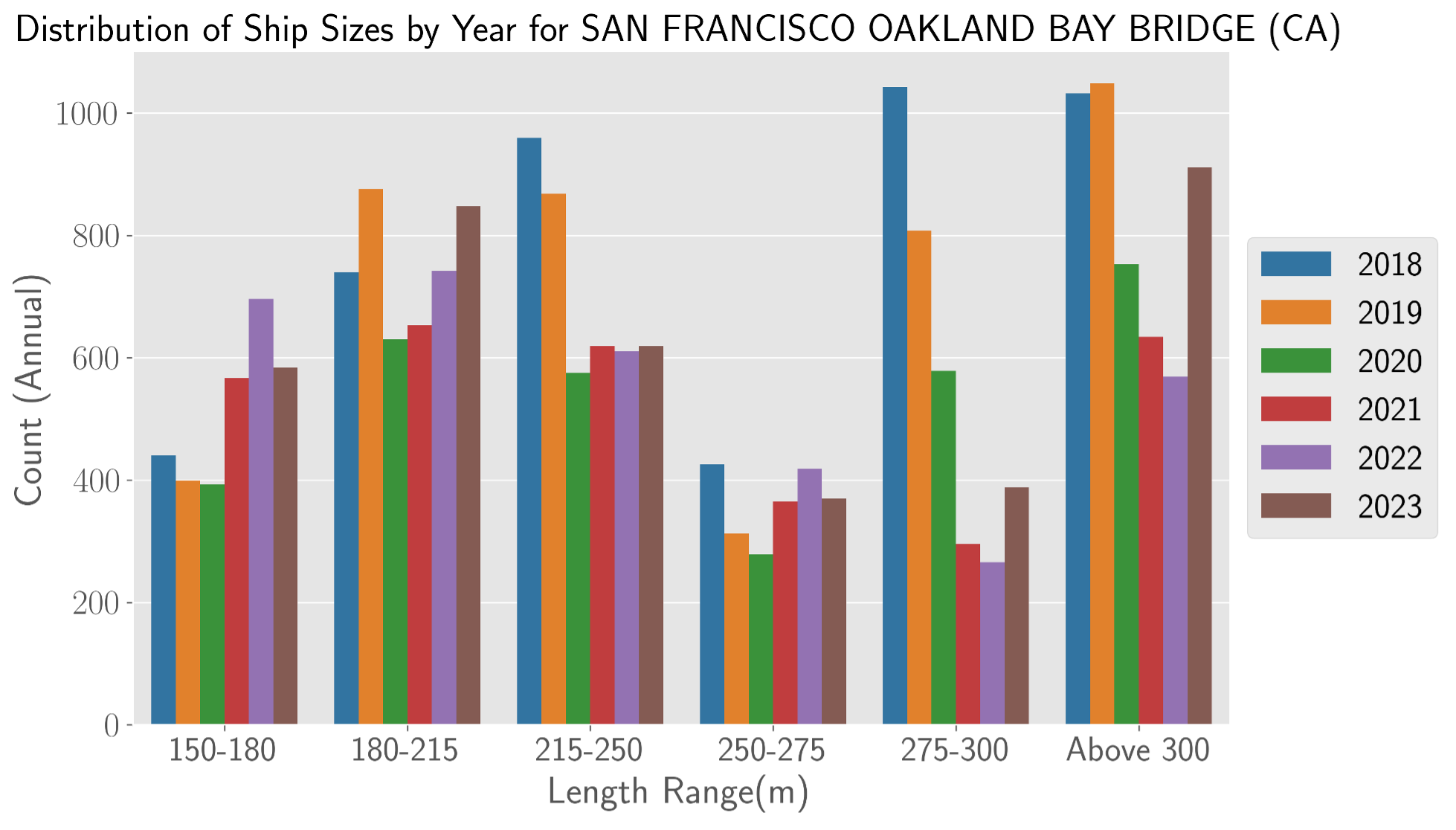
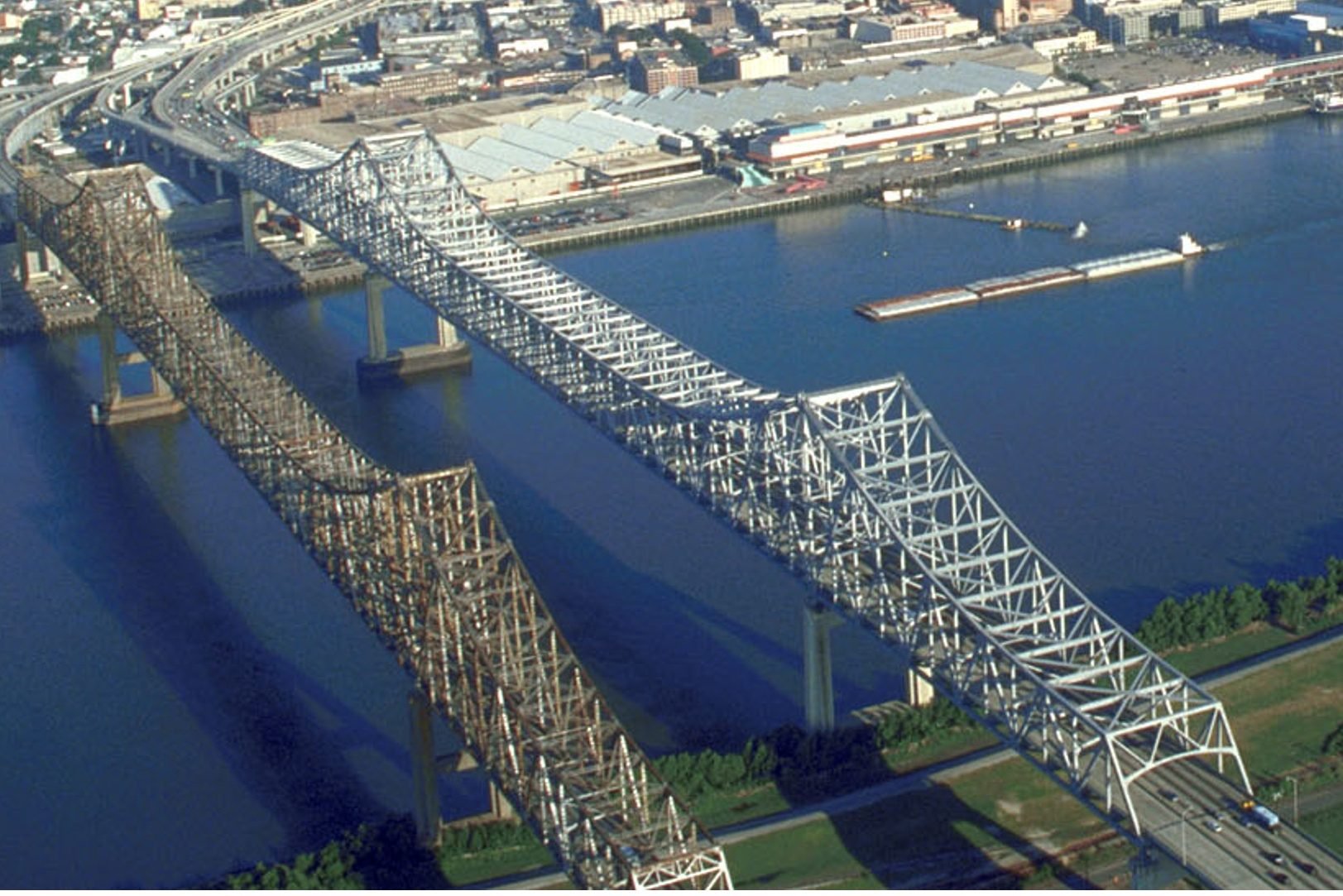
3
Crescent City Connection (LA)
Estimated Return Period of Collision: 34 years
Estimated Annual Probability of Collision: 3.0%
Read More
The Crescent City Connection (completed in 1958) refers to two parallel span steel truss bridges. Each is a three-span cantilevered steel truss bridge supported by reinforced concrete column bent piers. Each bridge has only a single pier in the waterway. The northern span is wider, but the piers on both bridges are nearly identical in the longitudinal bridge direction (the dimension used in the geometry factor calculation). The piers are protected by fenders. The pier dimension considers only the dimensions of the supporting column and not the foundation footprint at the water line.
The bridge sees and average of 22-23 large ships per day, which ranks 2nd nationally in large ship traffic. Like the Huey P. Long Bridge to its north, traffic is primarily from ships with length less than 250m, although several much larger ships pass through annually. It ranks 9th nationally in mega ship traffic. Nearly all traffic goes through the wider eastern span.
The bridge is expected to experience a major ship collision approximately once every 34 years.
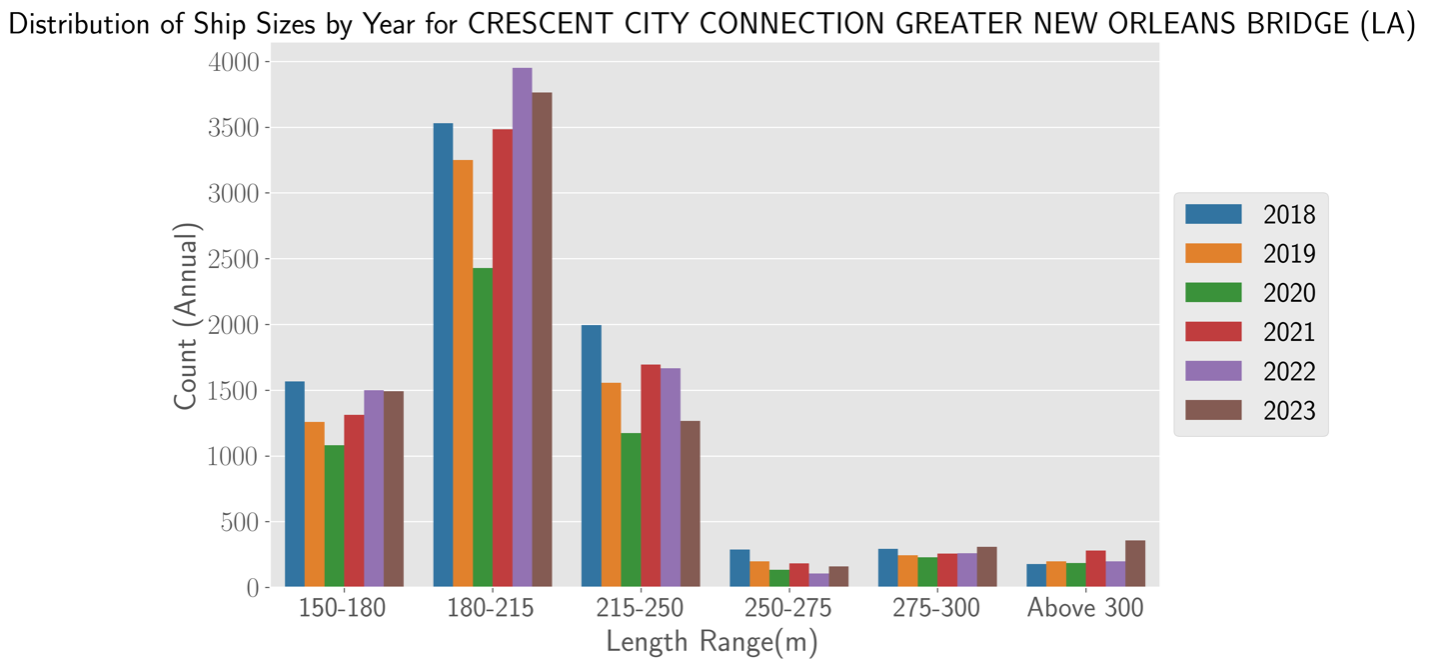
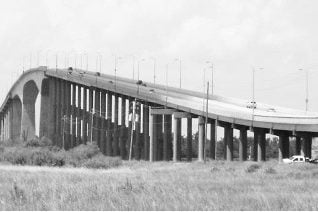
4
Texas Beltway 8 Bridge (aka Sam Houston Ship Channel Bridge) (TX)
Estimated Return Period of Collision: 35 years
Estimated Annual Probability of Collision: 2.9%
Read More
The Texas Beltway 8 Bridge (aka Sam Houston Ship Channel Bridge) is a post-tensioned concrete box girder superstructure supported by reinforced concrete single column piers. The pier dimensions do not include the dimensions of the protective stone islands but only the pier itself. Completed in 1982, a replacement structure is currently being designed.
The bridge sees and average of 14 large ships per day, which ranks 6th nationally in large ship traffic. Traffic is primarily from ships with length less than 250m, although a few much larger ships pass through annually.
The bridge is expected to experience a major ship collision approximately once every 35 years.
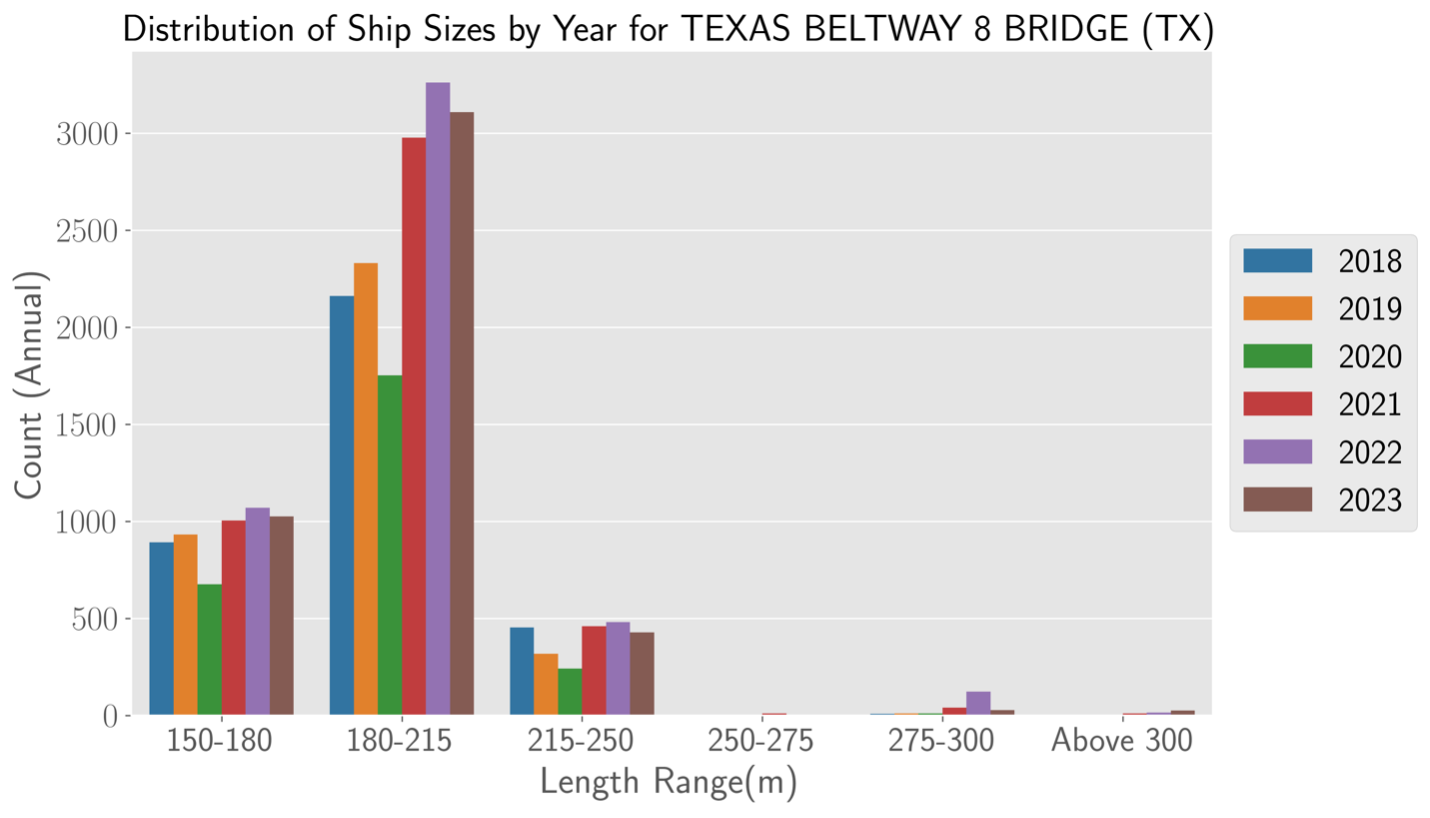
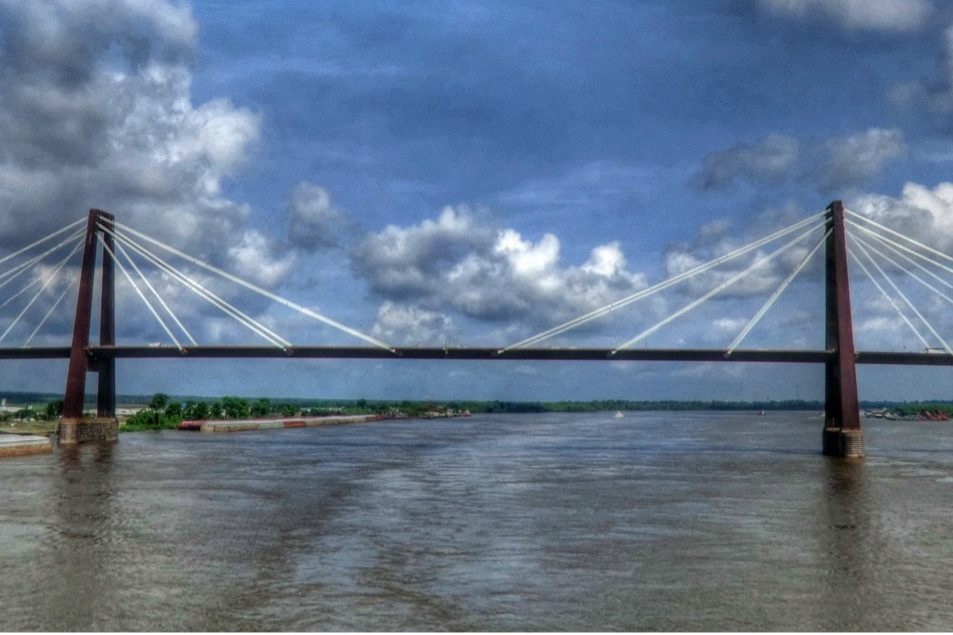
5
Hale Boggs Bridge (LA)
Estimated Return Period of Collision: 37 years
Estimated Annual Probability of Collision: 2.7%
Read More
The Hale Boggs Bridge is a three-span cable-stayed structure with steel towers. It was constructed in 1983 and crosses the Mississippi River. Concrete foundations are visible above the water line and there are no dolphins protecting the towers.
The bridge sees and average of 15 large ships per day, which ranks 5nd nationally in large ship traffic. Like the other spans across the southern Mississippi River, traffic is primarily from ships with length less than 250m, although a few much larger ships pass through annually. Although nearly all traffic passes under the main span between the two piers, some minor traffic passes through the span between the North bank and North pier
The bridge is expected to experience a major ship collision approximately once every 37 years.
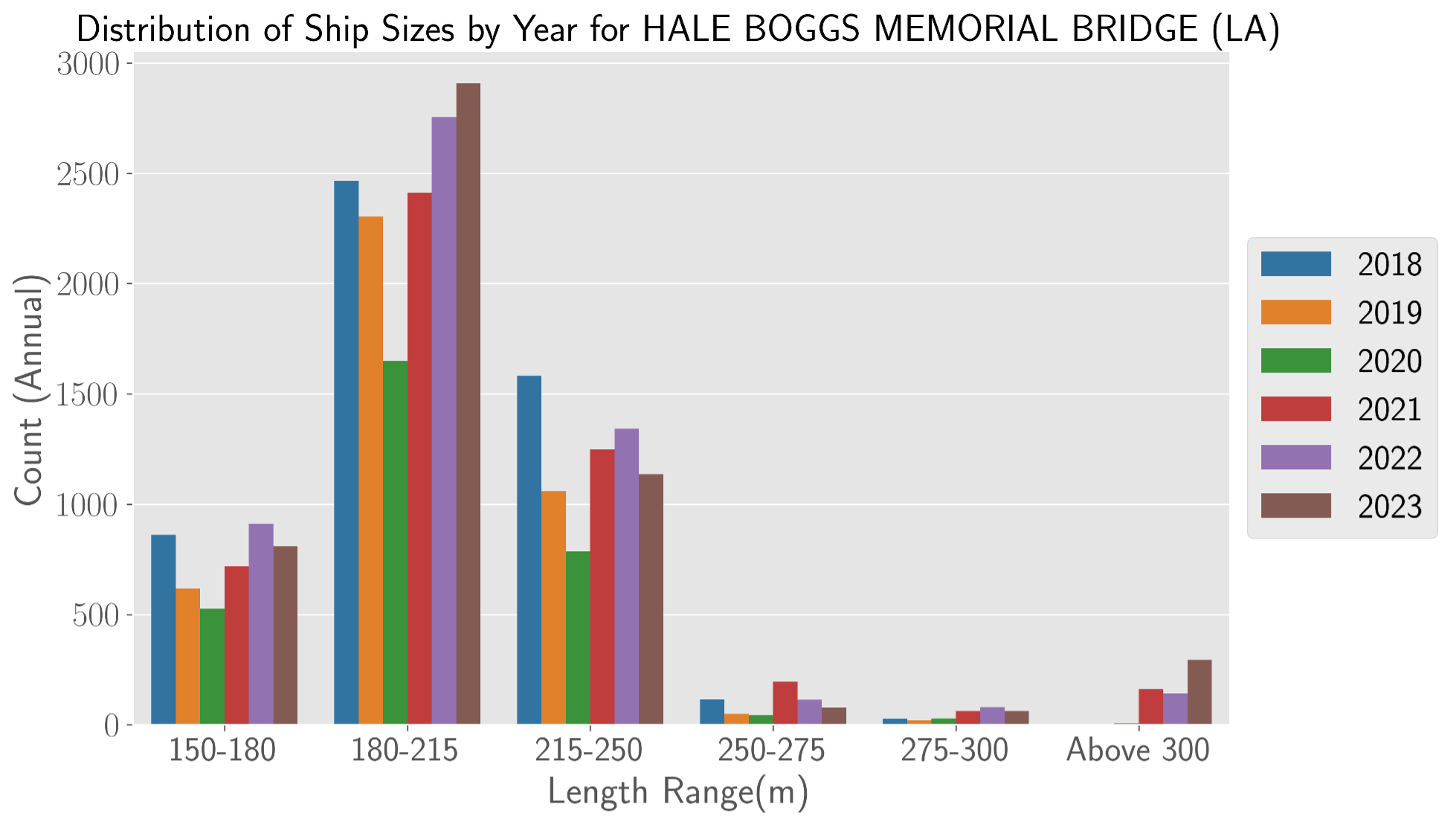
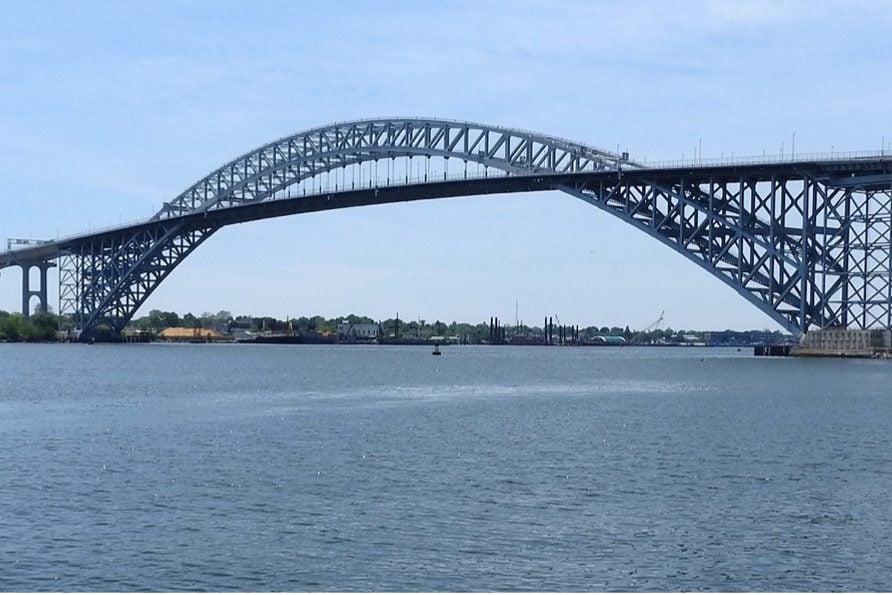
6
Bayonne Bridge (NY-NJ)
Estimated Return Period of Collision: 43 years
Estimated Annual Probability of Collision: 2.3%
Read More
The Bayonne Bridge is a steel half-through arch bridge with a single span. Built in 1931, the deck was raised in 2018 to make way for post-Panamax vessels. The trussed frame abutments are the edges of the channel and have only limited exposure to vessel traffic, but the ends of the arch may be struck by large aberrant vessels and so for this special case, we looked not only at the supporting pier structures, but also estimated that the arch may be vulnerable within 60m of each arch end. The south abutment is protected from eastbound traffic by a single dolphin.
The bridge sees an average of 5-6 large ships per day, which ranks 23rd nationally in large ship traffic and 5th nationally in mega ship traffic. Traffic is varied in size, but it regularly sees extremely large ship traffic, with an average of 1.2 mega ships passing per day.
Given the level of traffic it sees and the exposure of the arch truss, the bridge is expected to experience a major ship collision approximately once every 43 years.
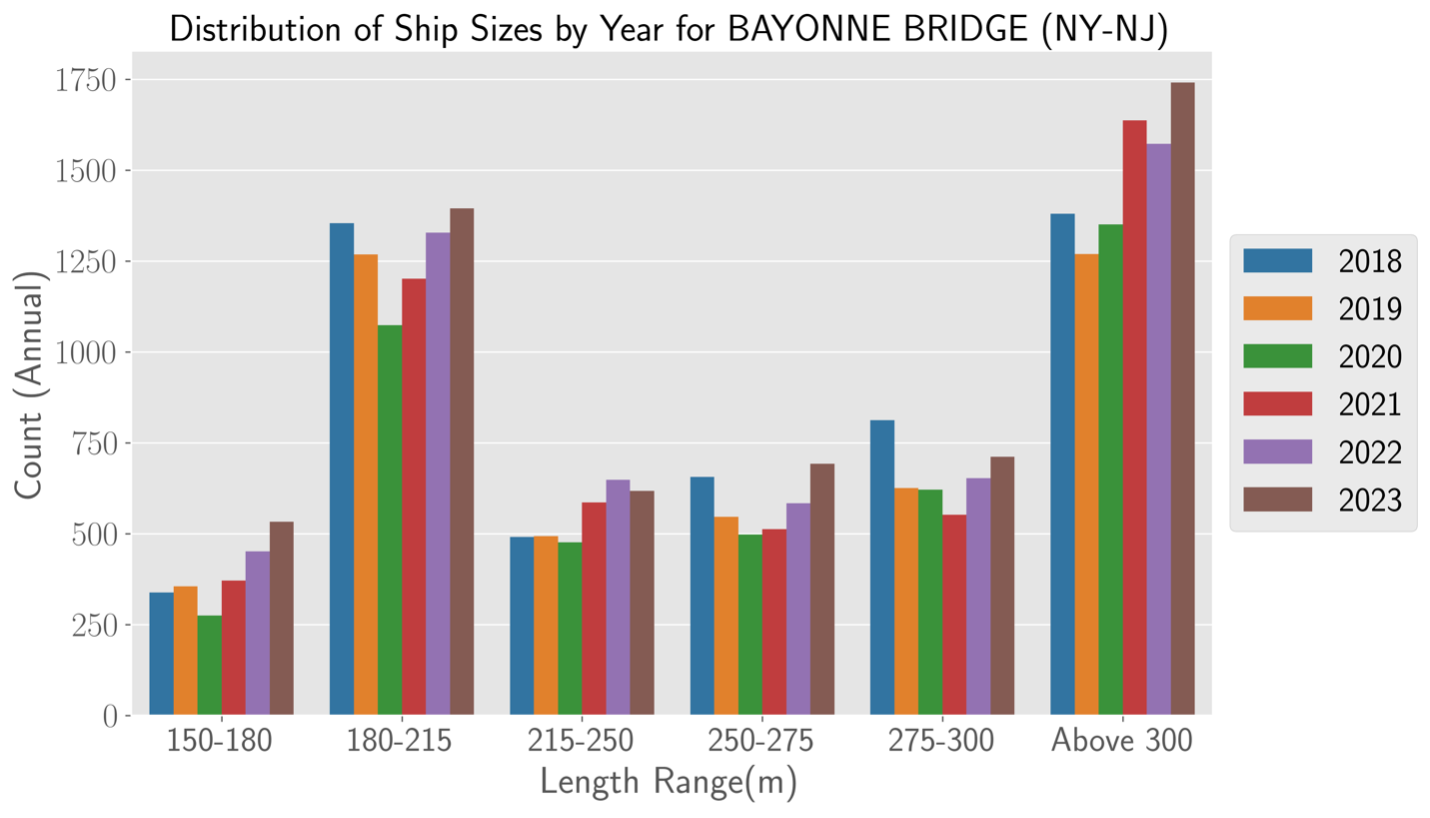
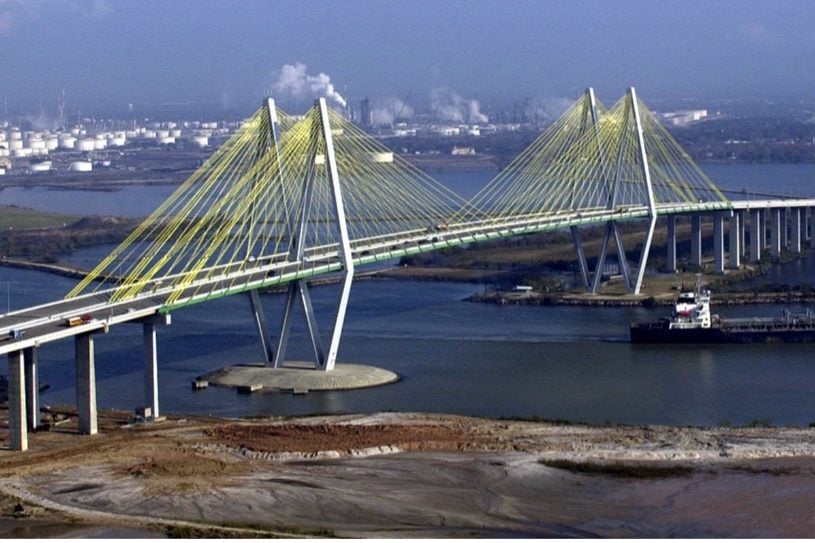
7
Fred Hartman Bridge (TX)
Estimated Return Period of Collision: 47 years
Estimated Annual Probability of Collision: 2.1%
Read More
The Fred Hartman Bridge (completed in 1995) is a three-span cable-stayed structure with reinforced concrete diamond-shaped towers, only one of which is in the water. That tower is surrounded by a sizeable island which provides protection to its slender tower. The bridge spans the Houston Ship Channel.
The bridge sees an average of approximately 30 large ships per day, making it the most highly trafficked bridge in the U.S. for large ships. Like the Texas Beltway 8 Bridge that spans the same waterway, traffic is primarily from ships with length less than 250m, although a few much larger ships pass through annually. All traffic passes through the main span.
The bridge is expected to experience a major ship collision approximately once every 47 years although major impacts may be mitigated by the large protective island.
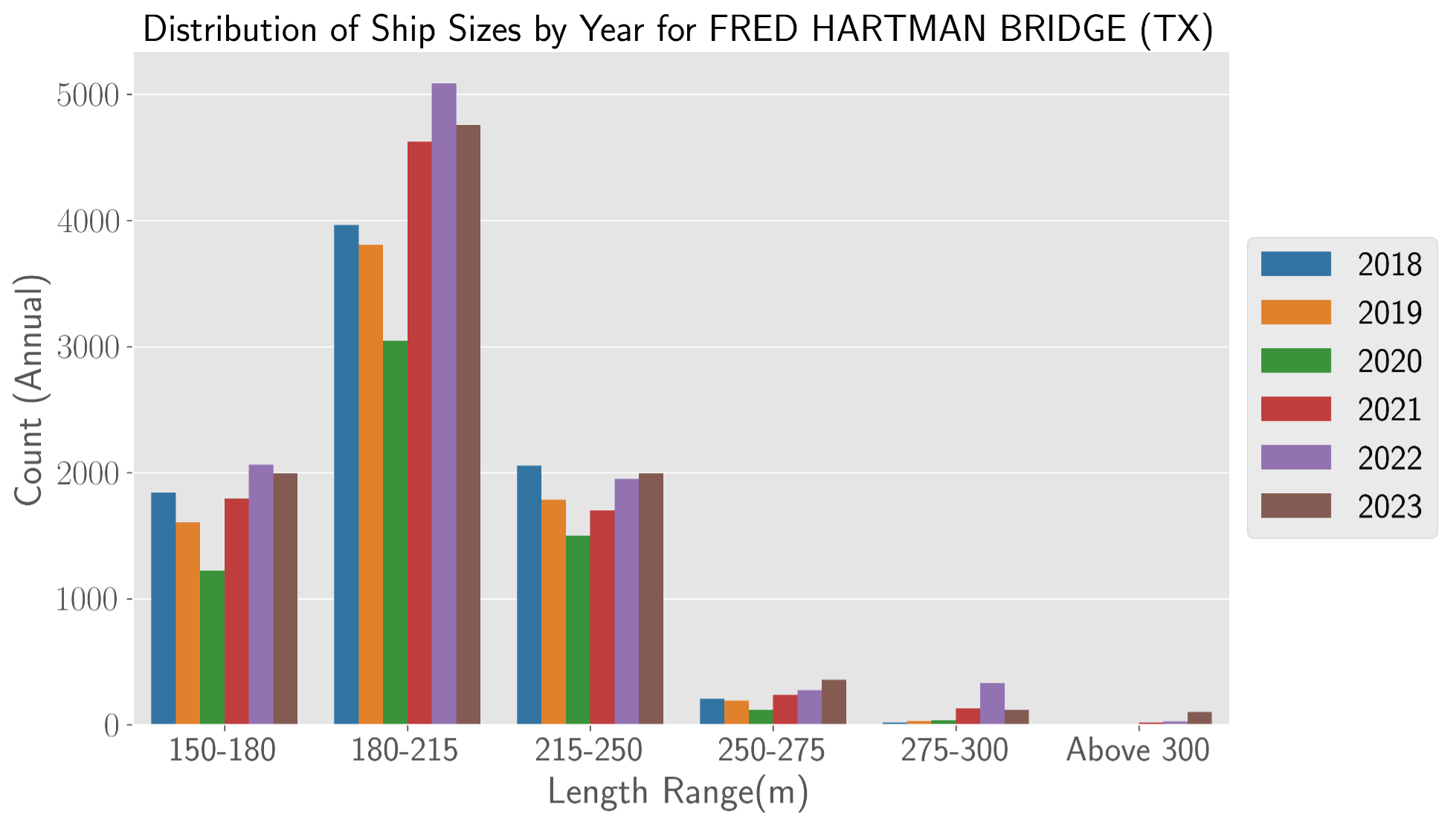
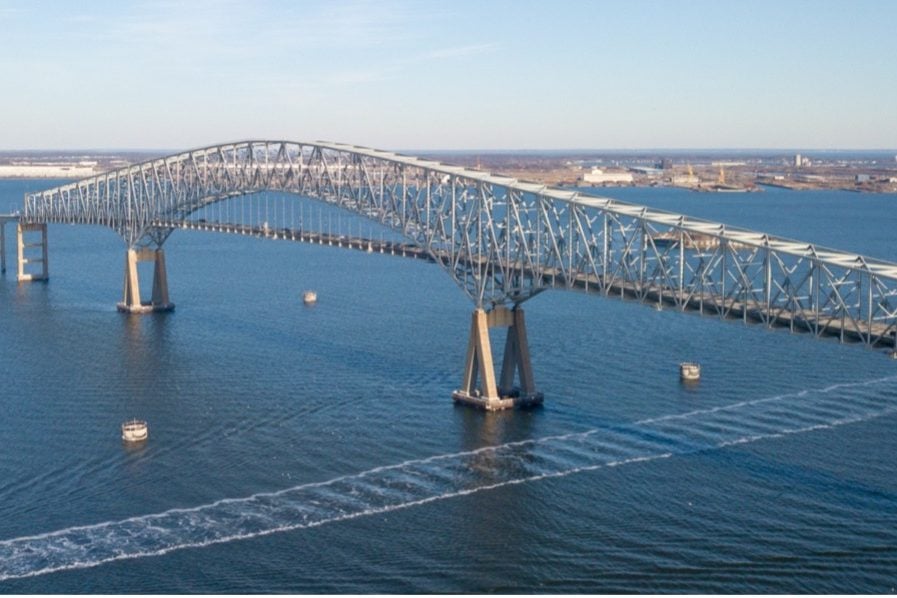
8
Francis Scott Key Bridge (MD)
Estimated Return Period of Collision: 49 years
Estimated Annual Probability of Collision: 2.1%
Read More
The Francis Scott Key Bridge (completed in 1977) was a three-span continuous steel truss bridge whose main span was supported by two primary reinforced concrete triangular frame piers. The piers had fenders and dolphins, but the dolphins were small (9m diameter) and they were placed far from the piers. On March 27, 2024 the bridge collapsed after collision from the MV Dali, a 300m freight vessel.
The bridge saw an average of 8-9 large ships per day, which ranked 13th nationally in large ship traffic and 7th nationally in mega ship traffic. Traffic is varied in size, but it regularly saw extremely large ship traffic, with an average of 1 mega ship passing per day. All traffic passed through the main span.
Given the level of traffic it saw and the lack of pier protections, the bridge was expected to experience a major ship collision approximately once every 49 years.
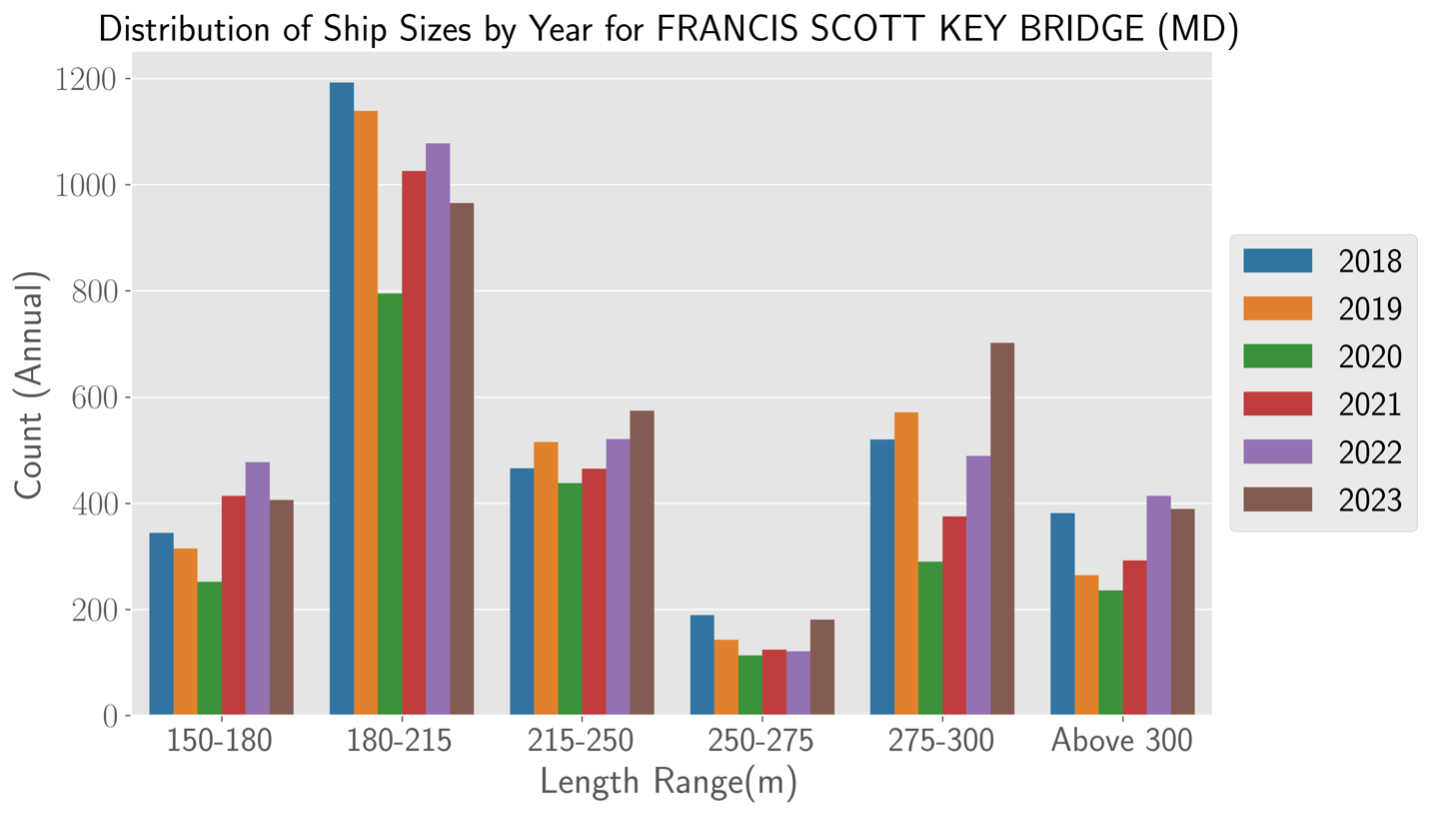
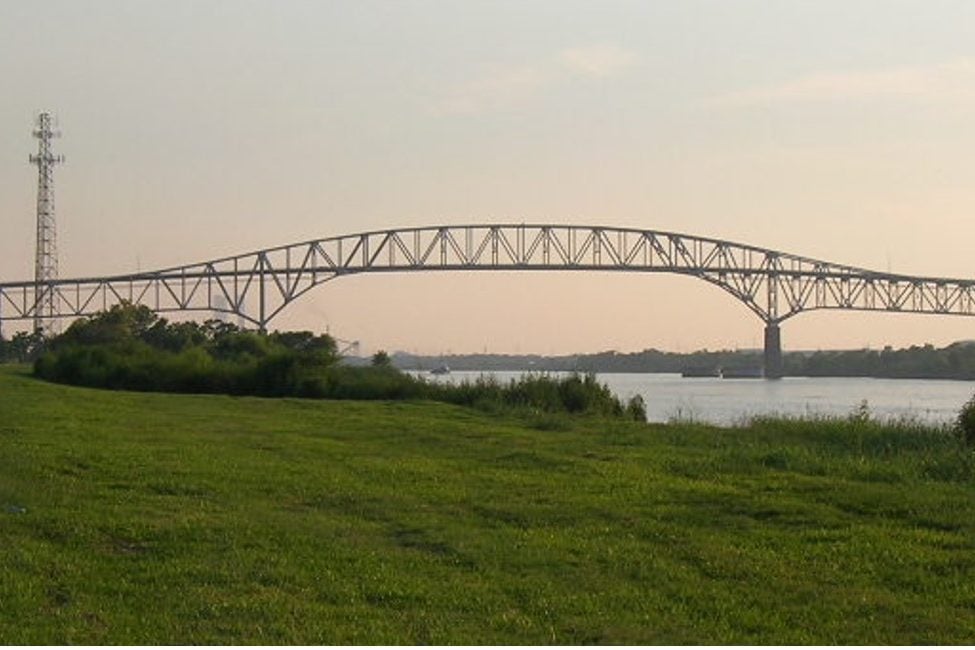
9
Gulfgate Bridge (aka Martin Luther King Jr. Bridge) (TX)
Estimated Return Period of Collision: 64 years
Estimated Annual Probability of Collision: 1.6%
Read More
The Gulfgate Bridge (aka Martin Luther King Jr. Bridge) carries Martin Luther King Jr. drive over the Sabine-Neches Canal in Port Arthur, Texas. The bridge (built in 1970) is a three-span steel cantilever truss bridge supported by reinforced concrete column bent piers. When measuring the pier width to use in the geometry factor calculation, the width considers only the column bents, which does not include the foundation visible above the water. Each pier is protected by two 15m diameter dolphins.
The bridge sees an average of approximately 10 large ships per day, which ranks 10th nationally in large ship traffic. Traffic is primarily from ships with length less than 250m, although several much larger ships pass through annually. All traffic passes through the main span supported by the two piers in the water.
Given the level of traffic it sees and the dolphin protection system in place, the bridge is expected to experience a major ship collision approximately once every 64 years.
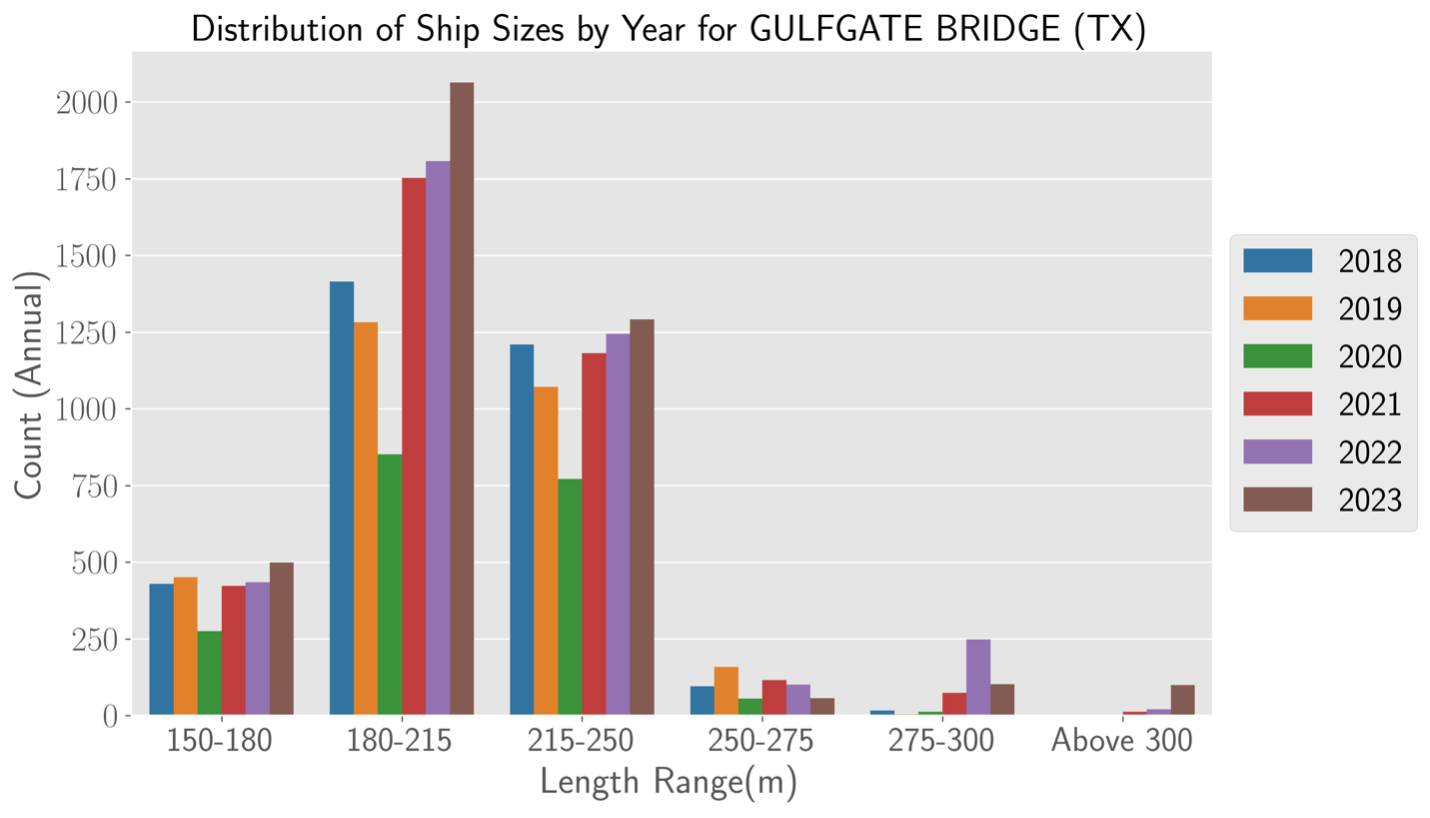
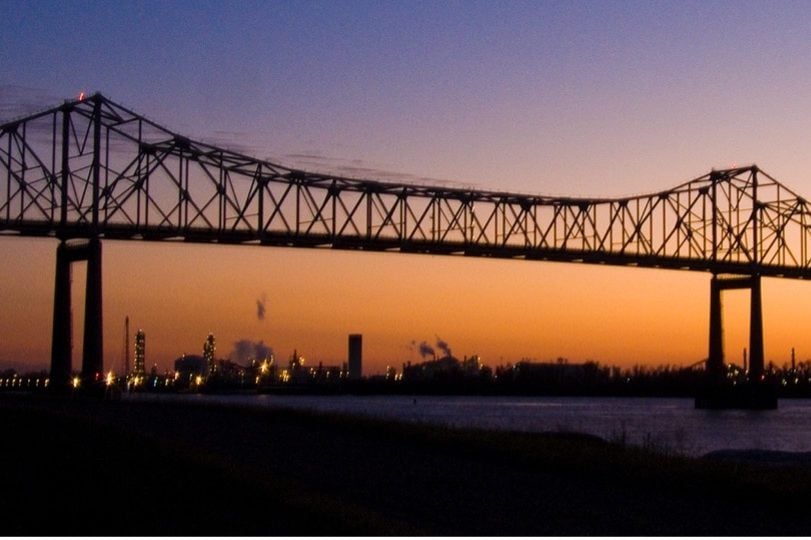
10
Sunshine Bridge (LA)
Estimated Return Period of Collision: 71 years
Estimated Annual Probability of Collision: 1.4%
Read More
The Sunshine Bridge is a five-span steel cantilever truss bridge spanning the Mississippi River at St. James Parish, LA. It was completed in 1964. Only three of its column bent piers (supported on caissons) are in the waterway and are considered here. The bridge has reportedly suffered from 21 vessel collisions since it opened. The piers are protected by fenders.
The bridge sees an average of 6 large ships per day, which ranks 20th nationally in large ship traffic. Traffic is primarily from ships with length less than 250m, although several much larger ships pass through annually. It ranks 15th nationally in mega ship traffic. The majority of the traffic passes through the northern span (between the north and middle piers), while the southern span (south and middle piers) sees a minor but appreciable amount of traffic.
The bridge is expected to experience a major ship collision approximately once every 71 years.
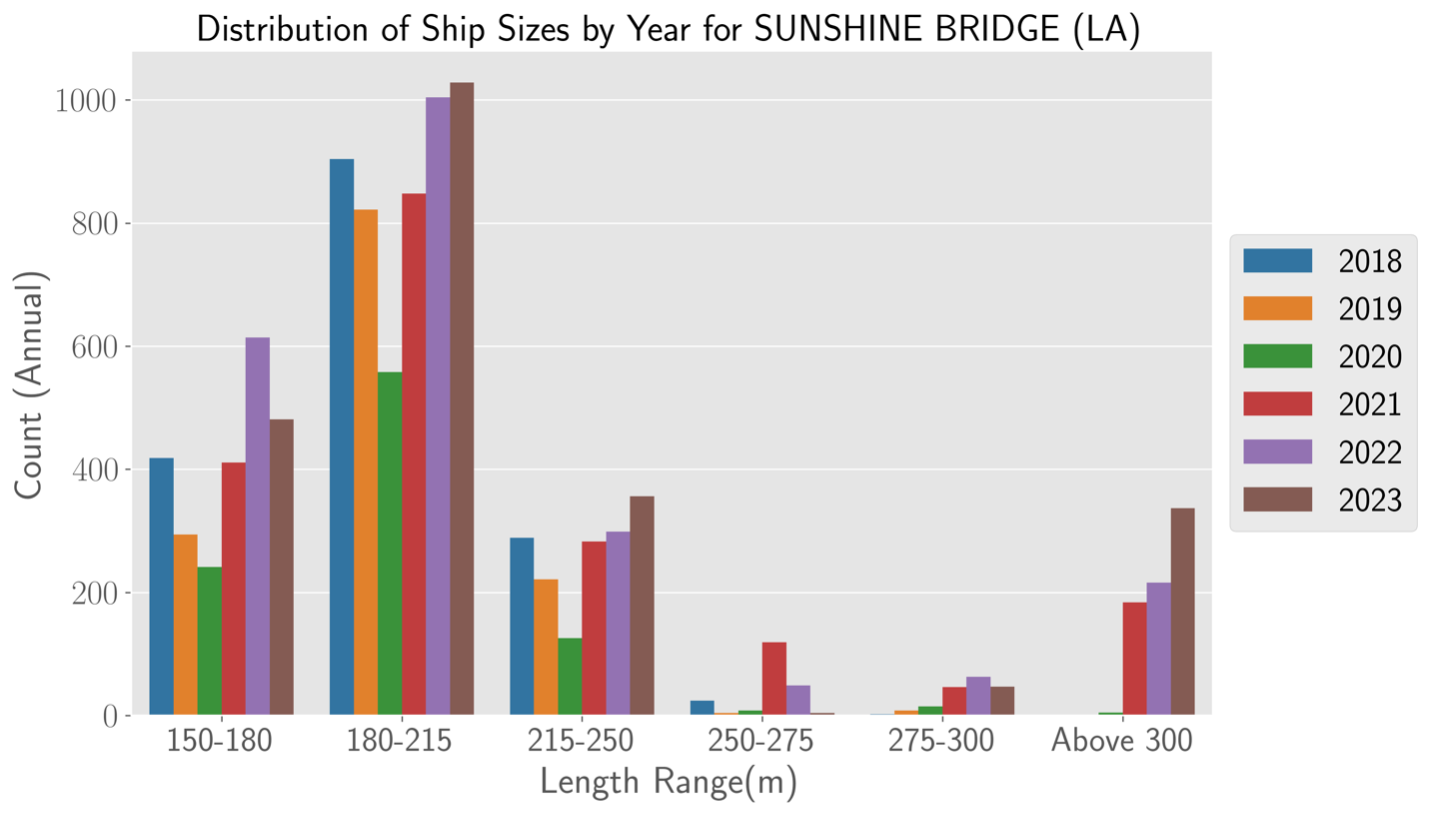
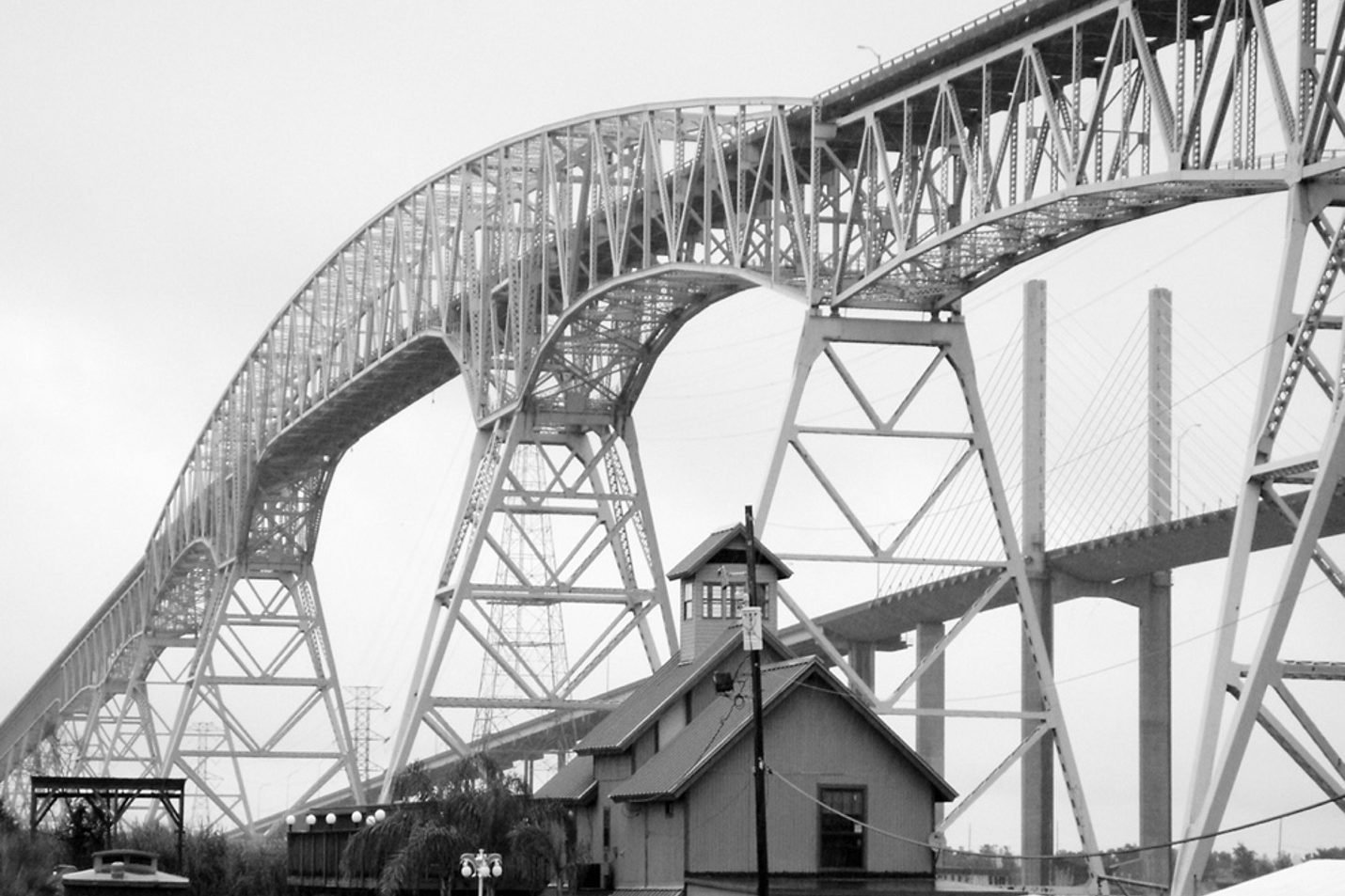
11
Rainbow Bridge (TX)
Estimated Return Period of Collision: 71 years
Estimated Annual Probability of Collision: 1.4%
Read More
The Rainbow Bridge was built in 1938 to span the Neches River which connects the Gulf of Mexico to Texas’s Port of Beaumont. The bridge is a steel truss with a cantilevered central span. The piers are different than any others on this list – they are steel trusses that widen in the longitudinal direction as they get further from the water (and narrower in the transverse direction for greater wind resistance). The pier measurement used to calculate the geometry factor was the maximum width at the top of the pier, where it meets the bottom of the superstructure. The piers on either side of the shipping channel are protected by 15.25m dolphins (2 per pier).
The bridge sees an average of 8 large ships per day, which ranks 15th nationally in large ship traffic. Traffic is primarily from ships with length less than 250m, although some much larger ships pass through annually. All traffic passes under the main span.
The bridge is expected to experience a major ship collision approximately once every 71 years.
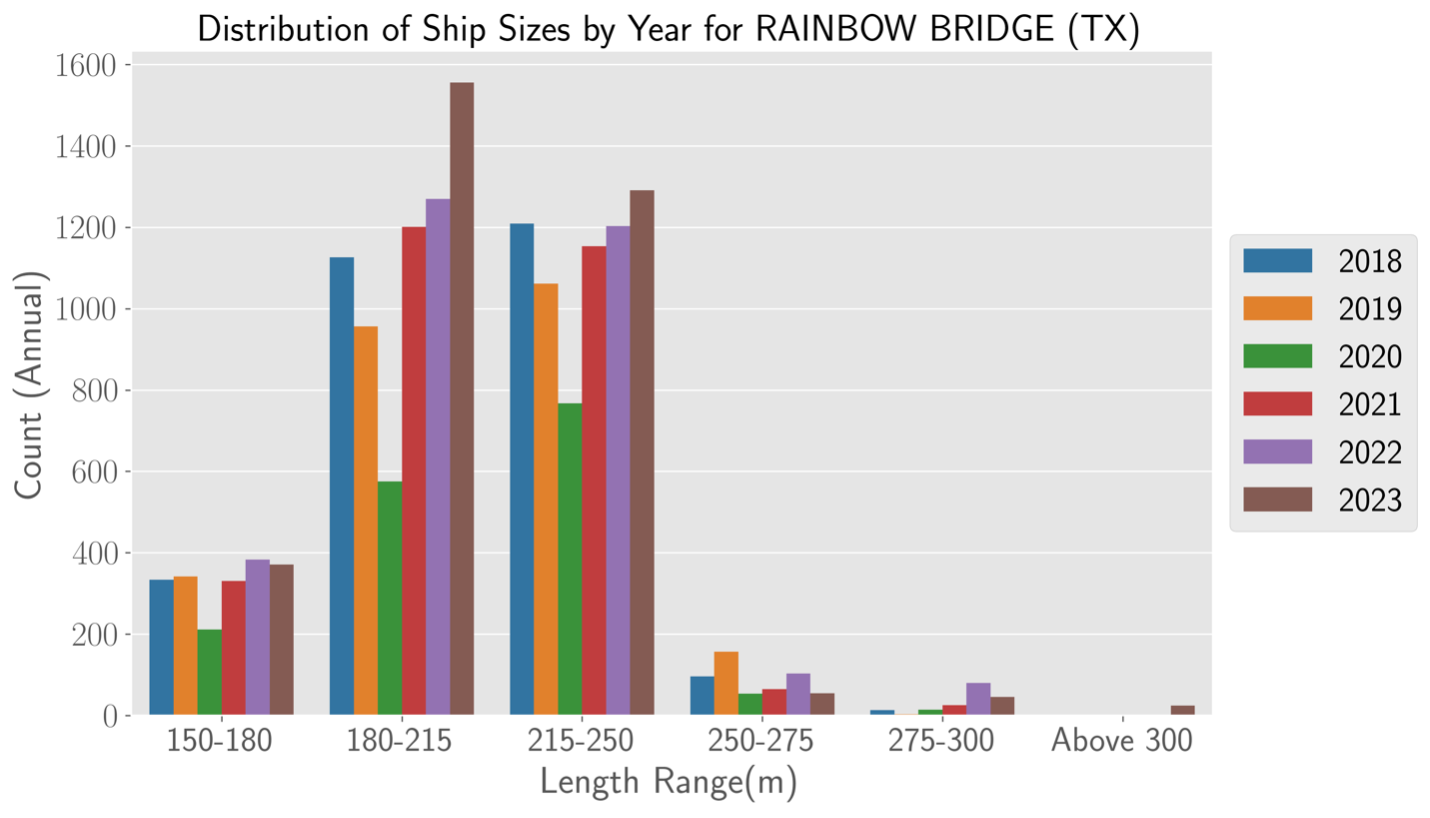
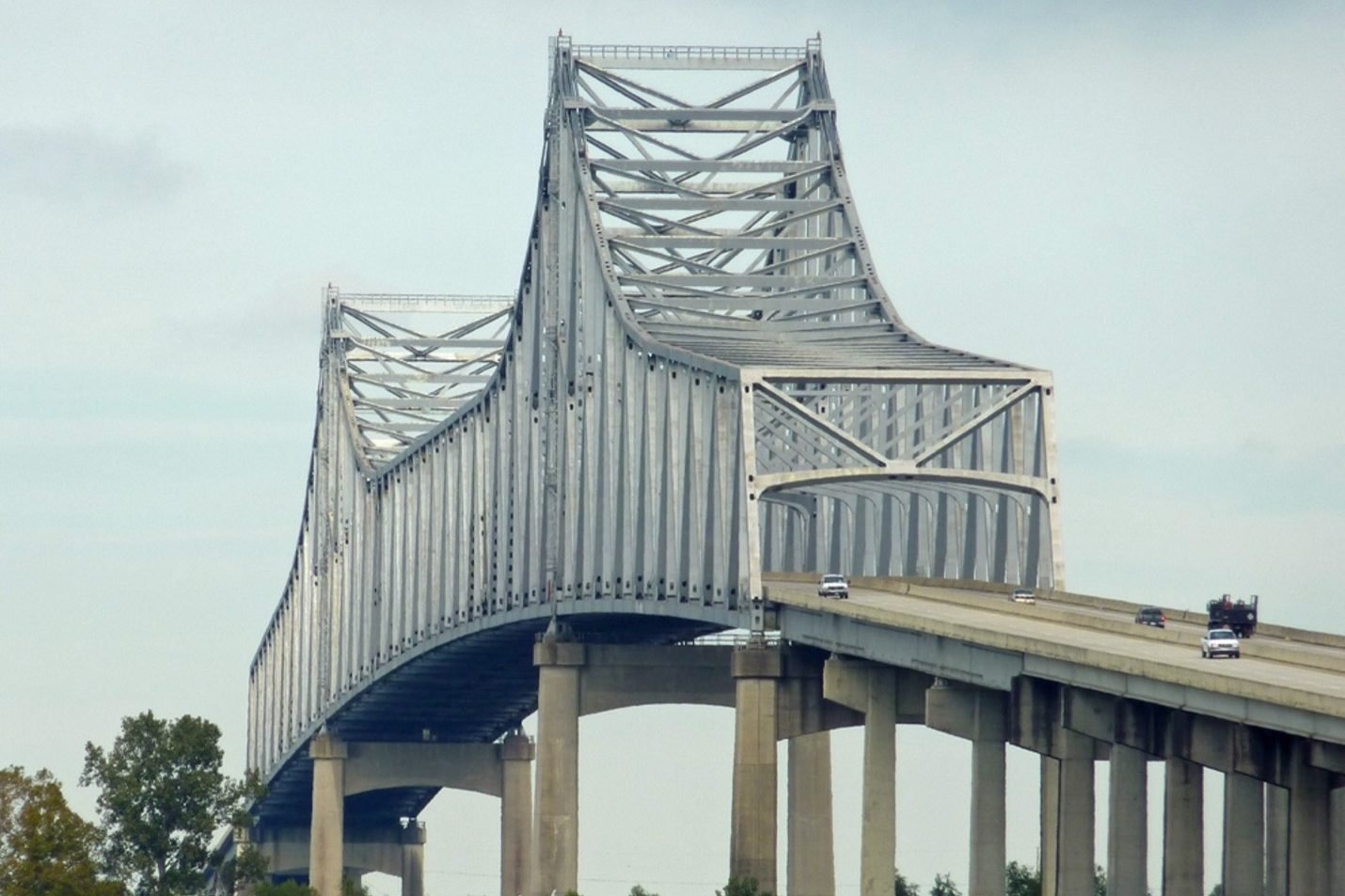
12
Gramercy Bridge (aka Veterans Memorial Bridge) (LA)
Estimated Return Period of Collision: 74 Years
Estimated Annual Probability of Collision: 1.4%
Read More
Gramercy Bridge (aka Veterans Memorial Bridge) is a three-span steel cantilever truss bridge spanning the Mississippi River in St. James Parish, LA (halfway between New Orleans and Baton Rouge). It was completed in 1995 and is supported on reinforced concrete column bent piers, supported on caissons. Only two piers are sufficiently exposed in the water to be vulnerable to a ship collision. The piers are not protected by dolphins, but they do have fenders.
The bridge sees an average of 9-10 large ships per day, which ranks 12th nationally in large ship traffic. Traffic is primarily from ships with length less than 250m, although several much larger ships pass through annually. The vast majority passes through the wider northern span, but some appreciable traffic passes through the narrower southern span as well.
The bridge is expected to experience a major ship collision approximately once every 74 years.
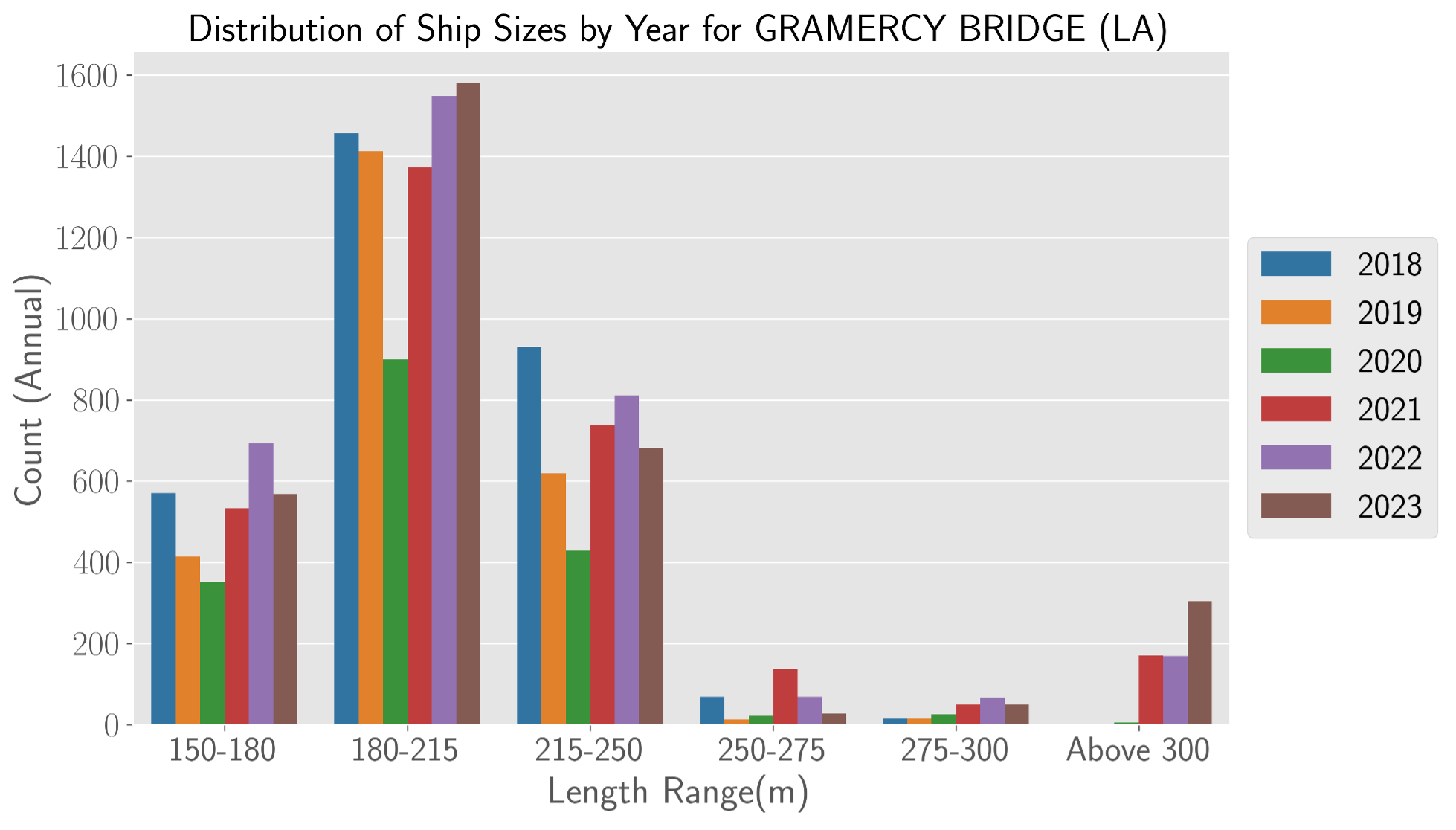
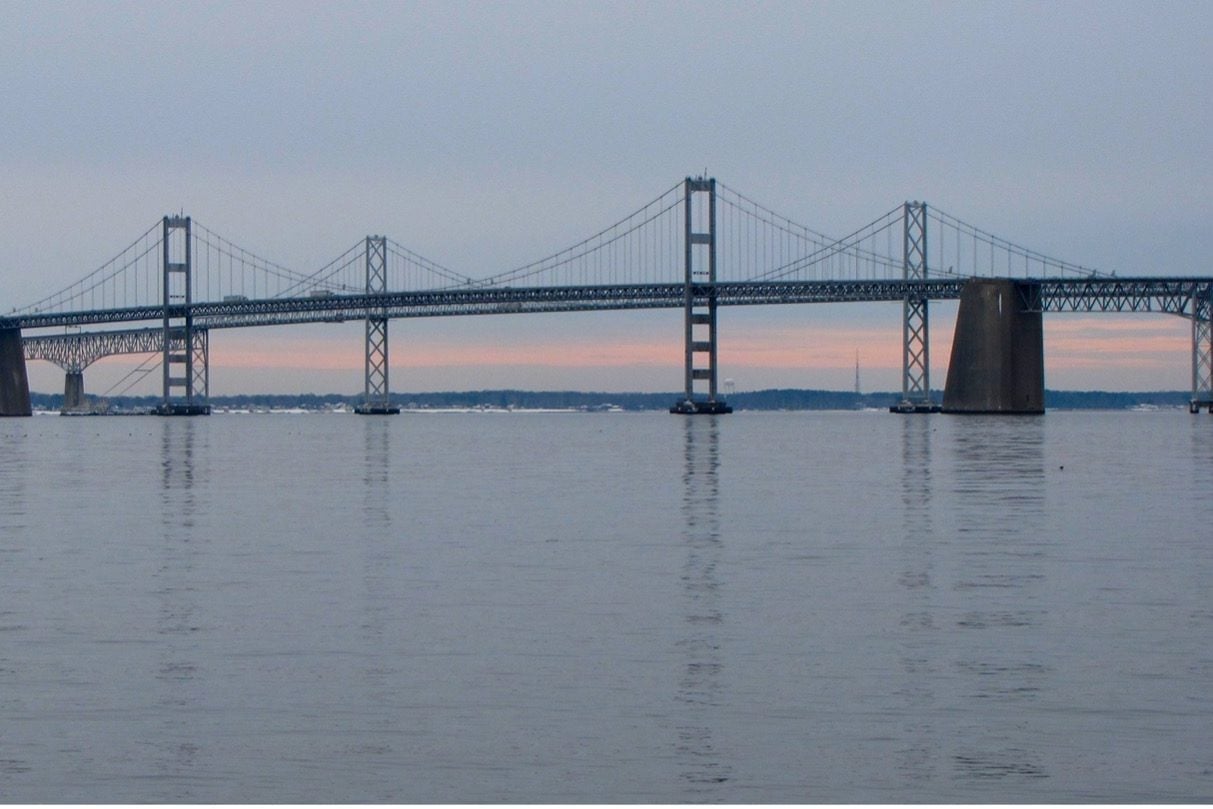
13
William Preston Lane Bridge (aka Chesapeake Bay Bridge) (MD)
Estimated Return Period of Collision: 86 Years
Estimated Annual Probability of Collision: 1.2%
Read More
The William Preston Lane Bridge (aka Chesapeake Bay Bridge) includes two parallel span bridges with multiple different forms. For our calculations, we only considered the suspension spans which are supported by steel towers on reinforced concrete foundations. The first span was completed in 1952, and the second span in 1973, but the four suspension towers have approximately the same footprint. Between its two spans, the bridge sees an average daily traffic of 80,000 vehicles. The towers are protected only by fenders, but plans are in the early stages to add additional pier protection, possibly dolphins.
The bridge sees an average of 8-9 large ships per day, which ranked 14th nationally in large ship traffic and 6th nationally in mega ship traffic. Traffic is varied in size and is nearly identical to the Francis Scott Key Bridge. It regularly sees extremely large ship traffic, with an average of 1 mega ship passing per day. On the central suspension span is wide enough for large ships to pass through.
The bridge is expected to experience a major ship collision approximately once every 86 years.
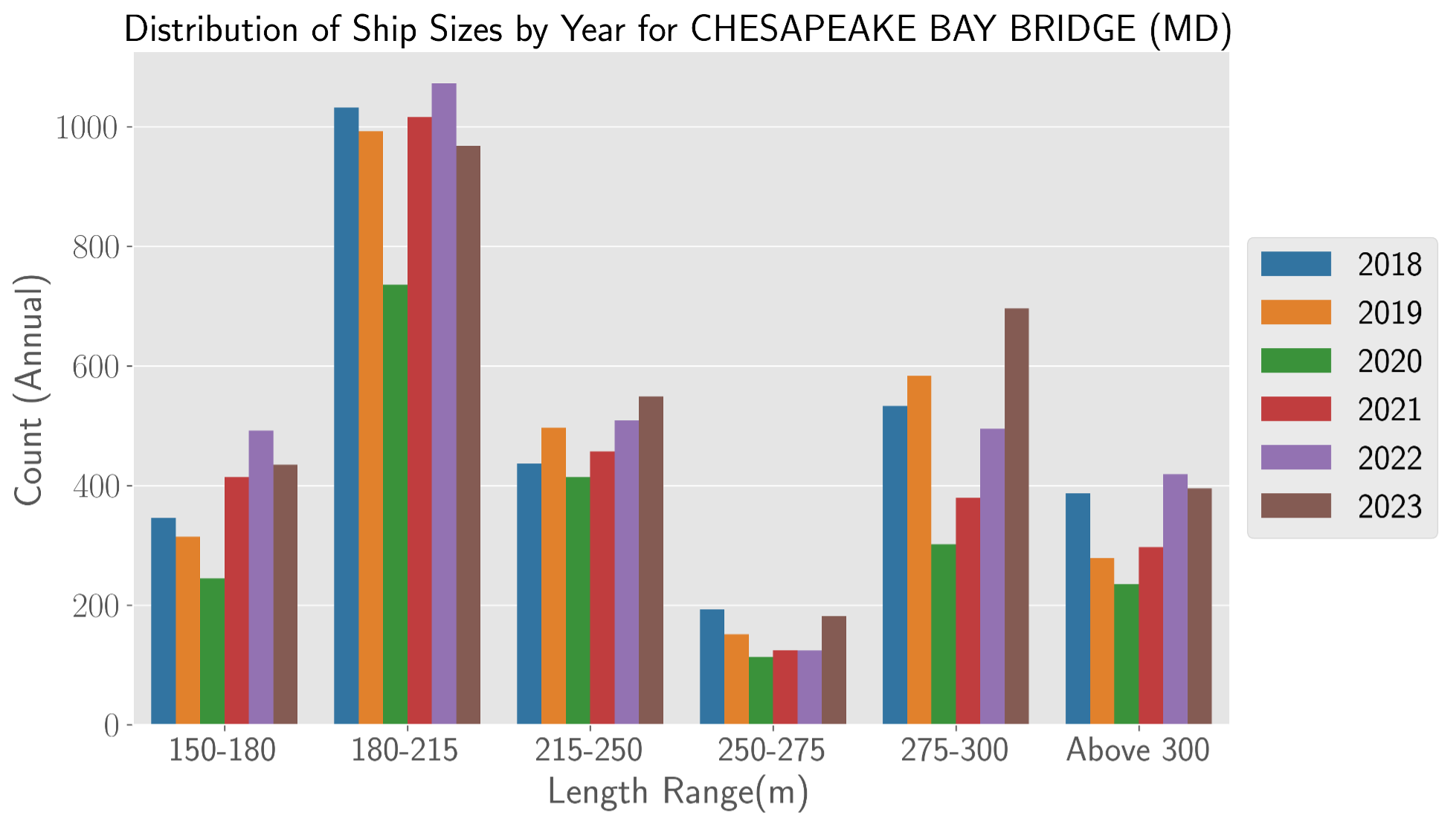
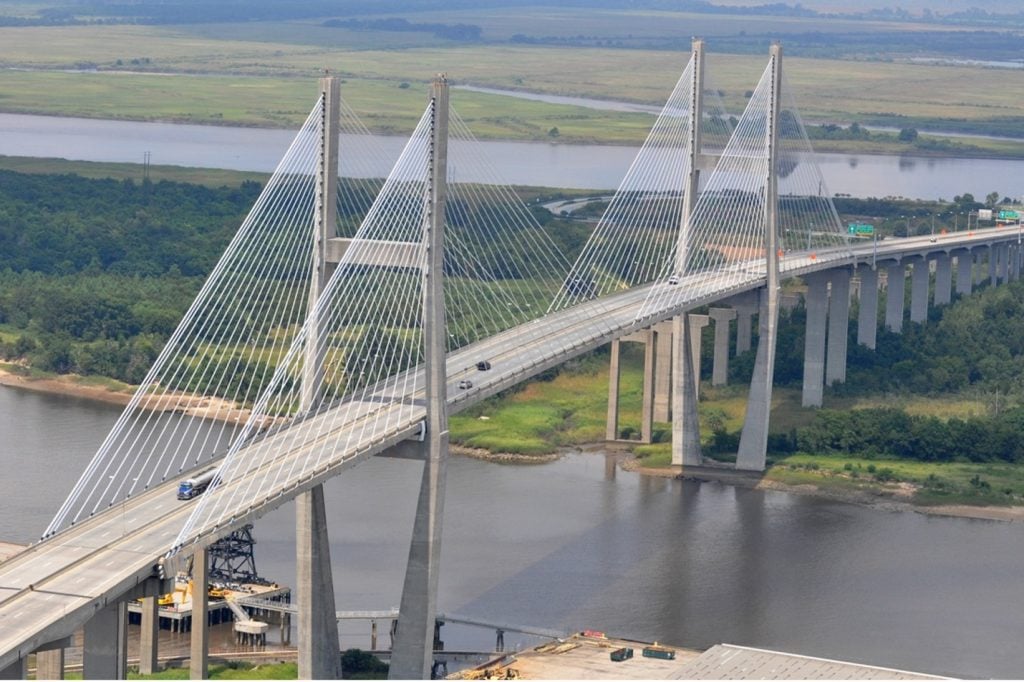
14
Talmadge Memorial Bridge (GA)
Estimated Return Period of Collision: 88 years
Estimated Annual Probability of Collision: 1.1%
Read More
The Talmadge Memorial Bridge (completed in 1991) spans the Savannah River in Savannah, Georgia is a cable-stayed bridge with reinforced concrete towers. The western-most tower is not in the channel and is entirely protected. The eastern-most tower is at the edge of the channel and is the only tower considered here.
The bridge sees an average of 9-10 large ships per day, which ranked 11th nationally in large ship traffic and 6th nationally in mega ship traffic. Approximately 1/3 of ship traffic under the bridge are extremely large vessels, making it the 2nd most trafficked bridge for mega size ships with an average of 3-4 mega ships passing per day.
Given the level of extremely large vessel traffic it sees and the exposure of the eastern pier, the bridge is expected to experience a major ship collision approximately once every 88 years.
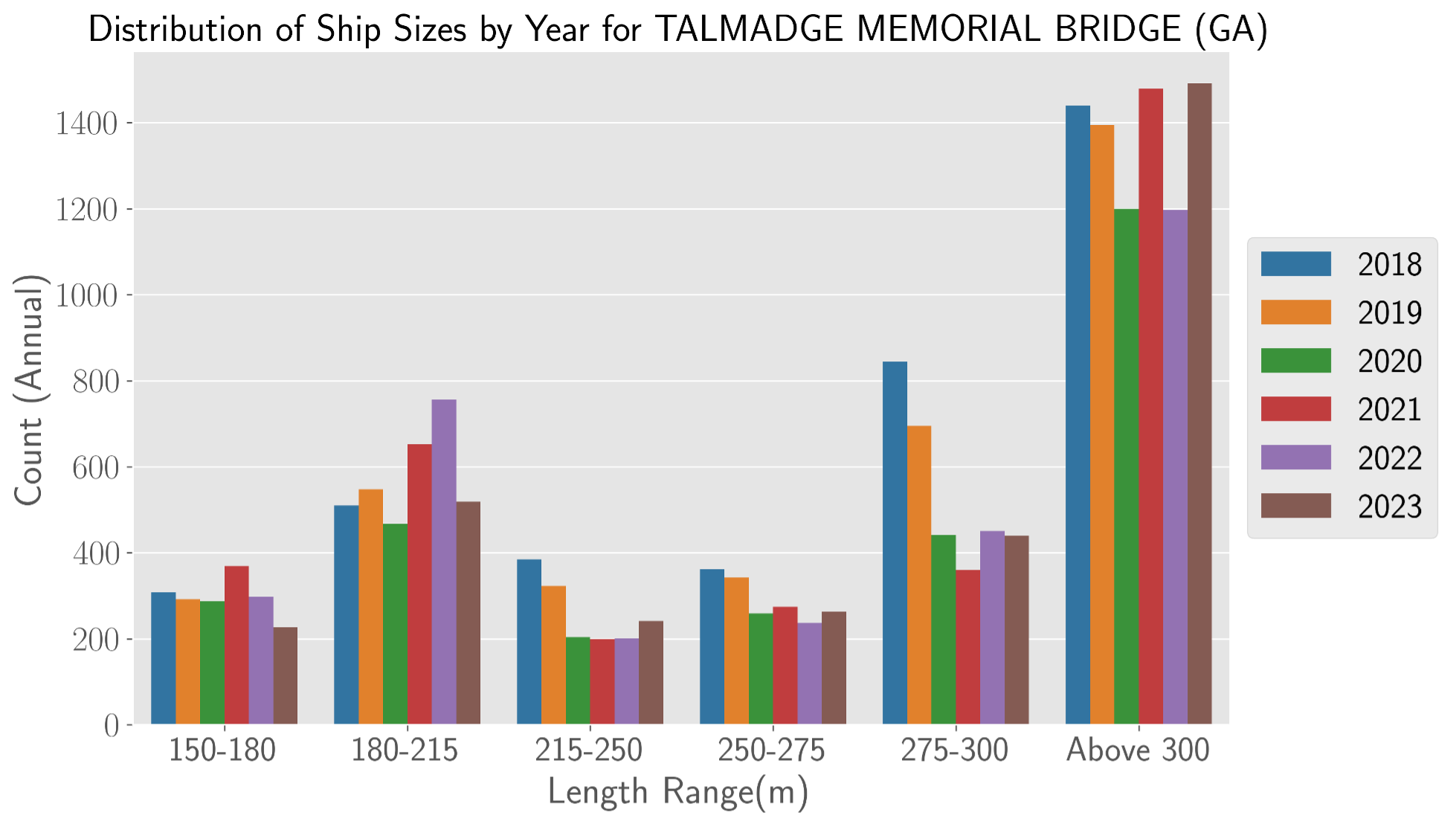
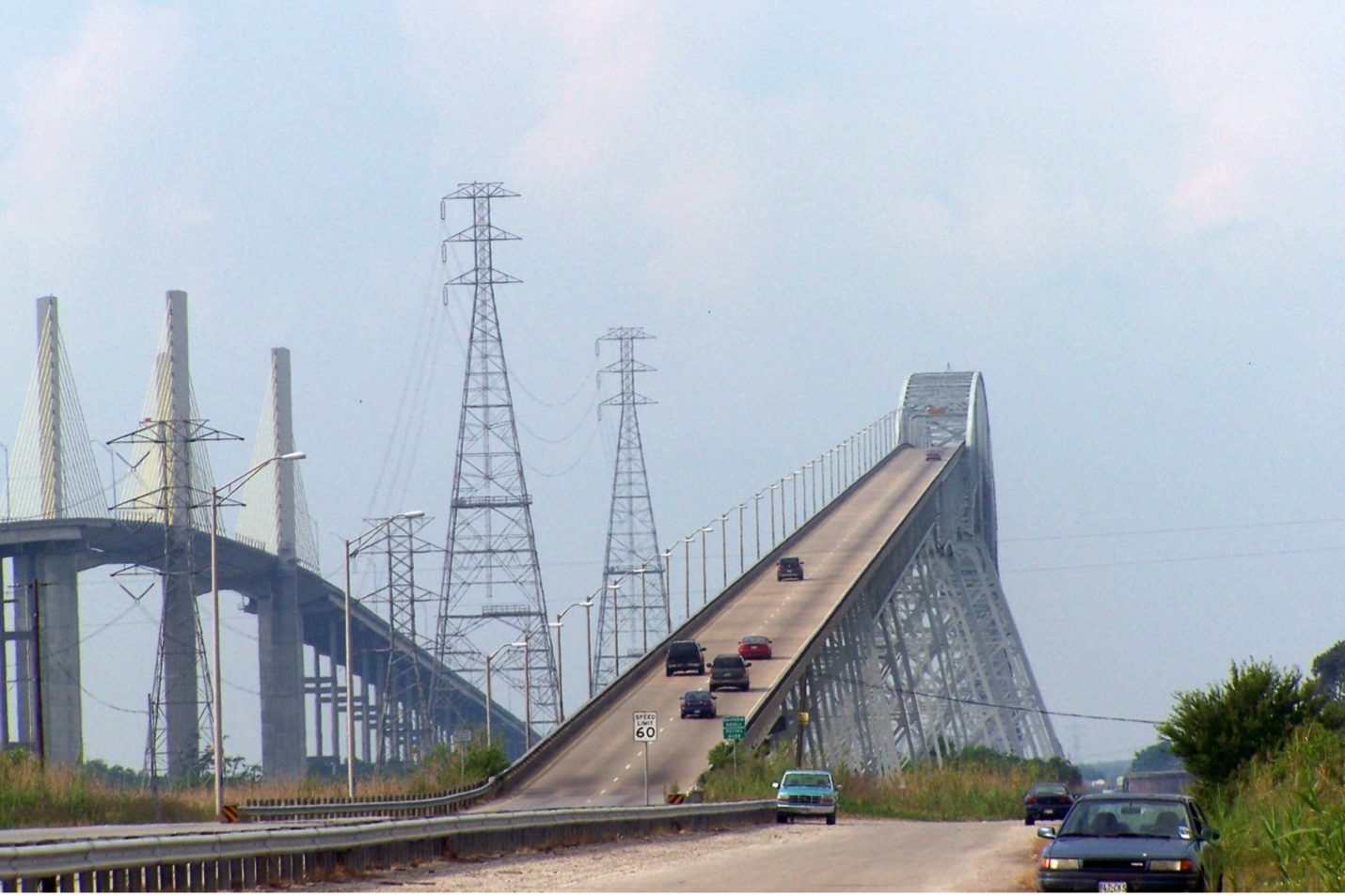
15
Veteran’s Memorial Bridge (TX)
Estimated Return Period of Collision: 94 years
Estimated Annual Probability of Collision: 1.1%
Read More
The Veteran’s Memorial Bridge is parallel to the Rainbow Bridge and was built in 1991 as a cable-stayed form with reinforced concrete towers. Like the Rainbow Bridge, the towers of the Veteran’s Memorial Bridge are protected by 16.5m dolphins (2 per tower).
The bridge sees an average of 8-9 large ships per day, which ranked 15th nationally in large ship traffic. Traffic is primarily from ships with length less than 250m, although some much larger ships pass through annually.
The bridge is expected to experience a major ship collision approximately once every 94 years.
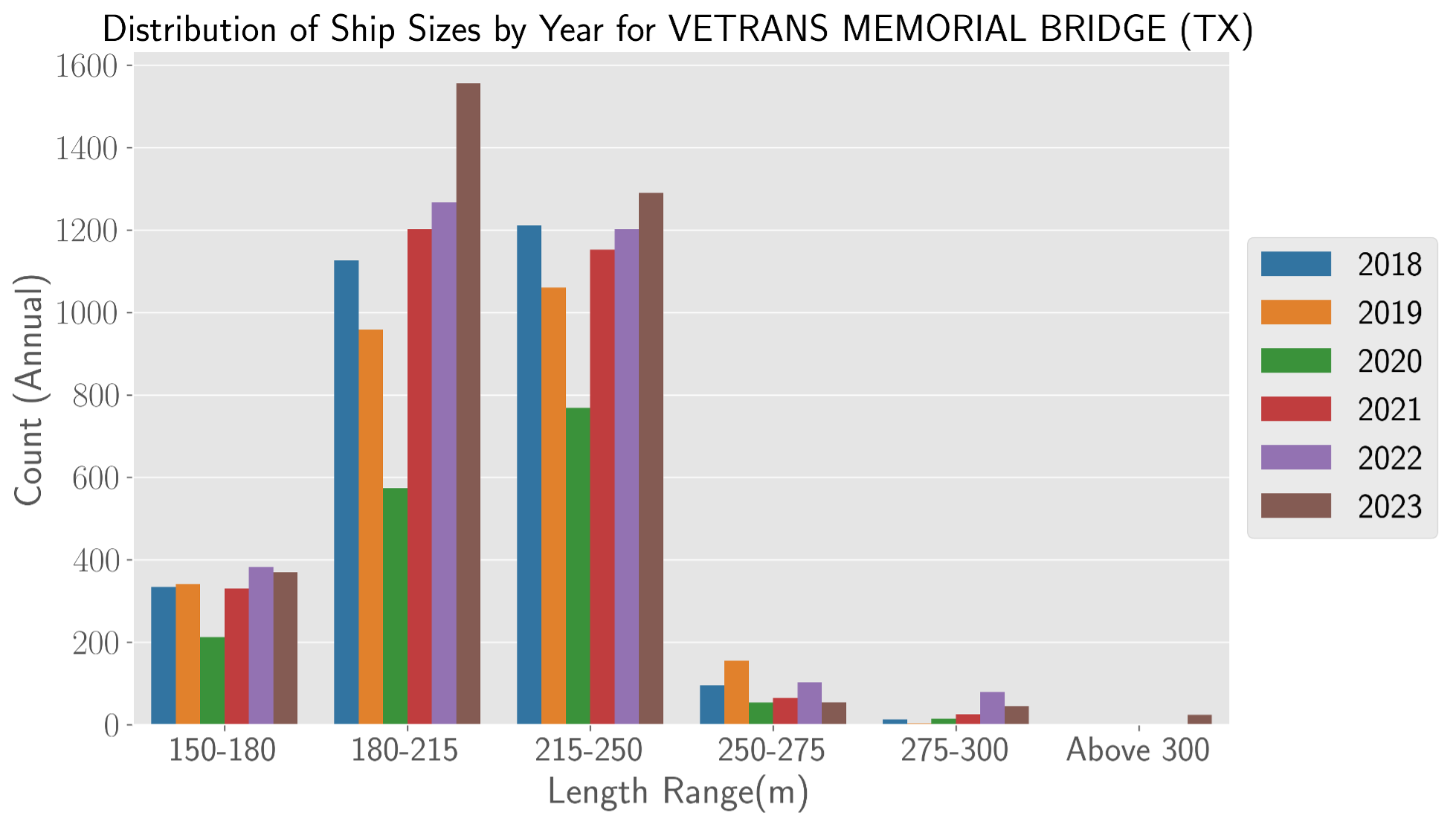
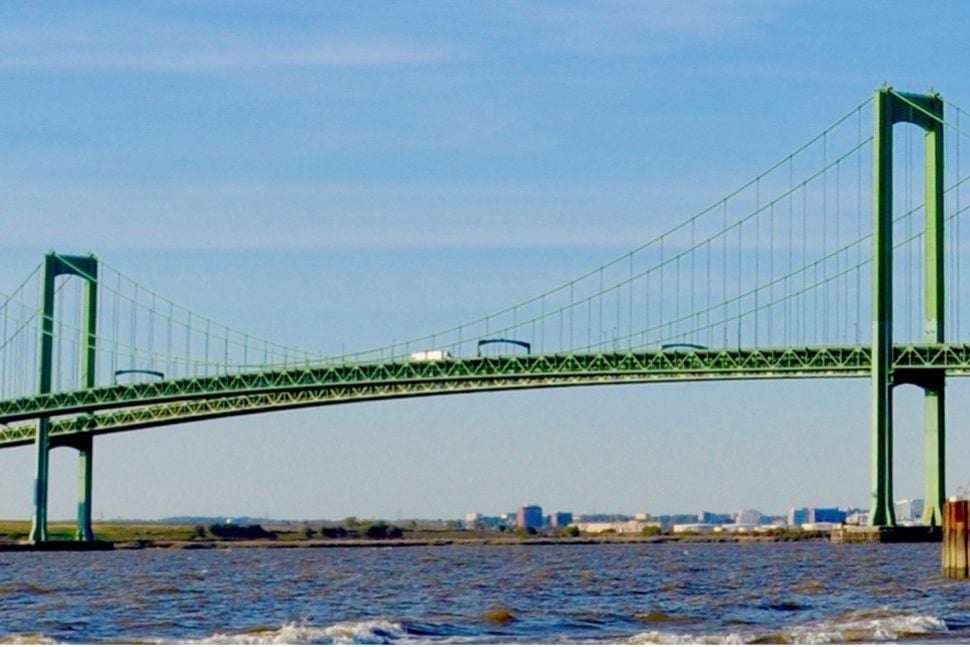
16
Delaware Memorial Bridge (DE-NJ)
Estimated Return Period of Collision: 129 years
Estimated Annual Probability of Collision: 0.7%
Read More
The Delaware Memorial Bridge (first span completed in 1951, second span in 1969) is a dual span (i.e. two bridges) suspension bridge with steel towers. Each pair of towers is connected by a single reinforced concrete foundation, so the pier dimensions refer to an individual tower’s dimensions (out to out of tower legs) and not those of the footing. Between its two spans, the bridge sees an average daily traffic of 100,000 vehicles. While the towers were originally protected only by fenders, eight stone-filled dolphins, four around each suspension tower, are currently under construction. Because our calculations rely heavily on satellite imagery of the bridges, and the imagery has not been updated since construction on the dolphins began, they are not considered in our current protection factor calculations.
The bridge sees an average of 10-11 large ships per day, which ranks 8th nationally in large ship traffic. Although it sees mostly ships that are less than 250m in length, it sees some traffic of the largest vessels. All traffic passes through the main span supported by the two piers in the water.
The bridge is expected to experience a major ship collision approximately once every 129 years.
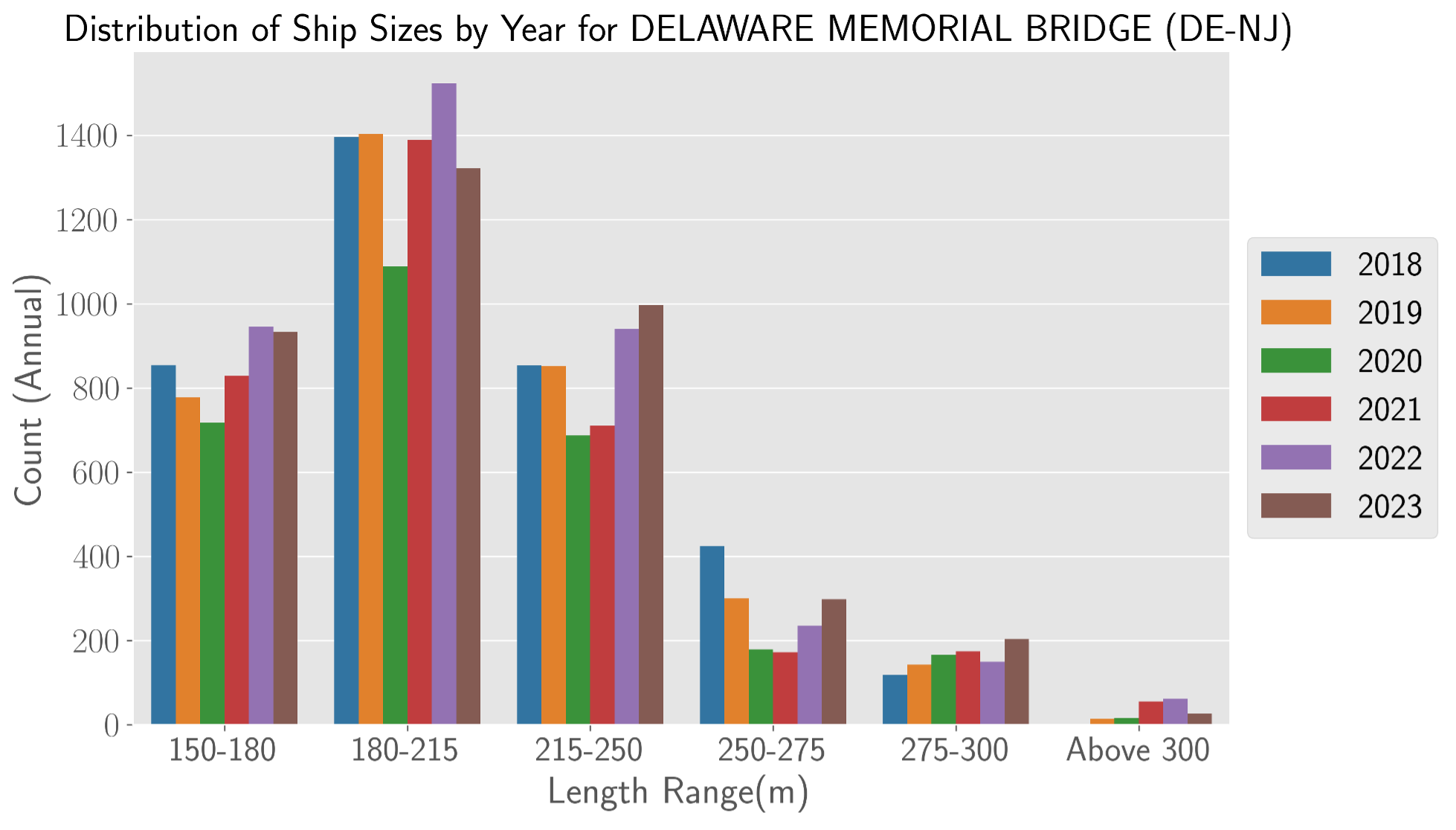
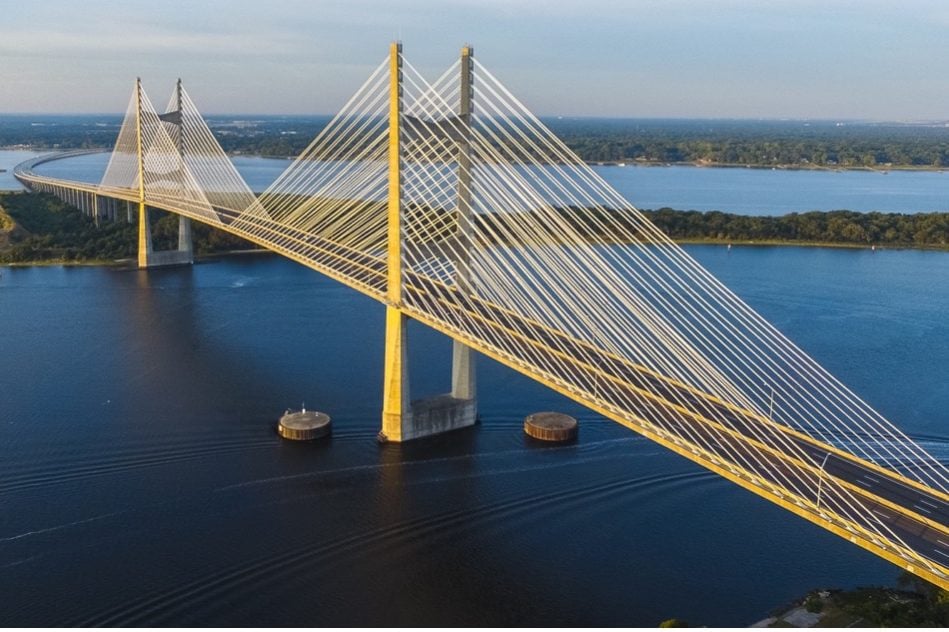
17
Dames Point Bridge (FL)
Estimated Return Period of Collision: 152 years
Estimated Annual Probability of Collision: 0.7%
Read More
Dames Point Bridge (completed in 1989) in Jacksonville, FL spans the Saint Johns River with a cable-stayed bridge supported by two reinforced concrete towers. The northernmost tower is protected by two-19m dolphins, and the south tower, which is nearly at the edge of the waterway, is protected by a rock island. The pier measurements (for geometry factor calculations) ignore the rock island around the south tower. Additional details can be found here: https://onlinepubs.trb.org/Onlinepubs/trr/1991/1290vol1/1290-032.pdf
The bridge sees an average of 4 large ships per day, which ranks 27th nationally in large ship traffic. However, it sees many of the largest ships, ranking 14th nationally in mega ship traffic with approximately one mega ship every other day. All traffic passes through the wide span south of the main pier.
The bridge is expected to experience a major ship collision approximately once every 152 years.
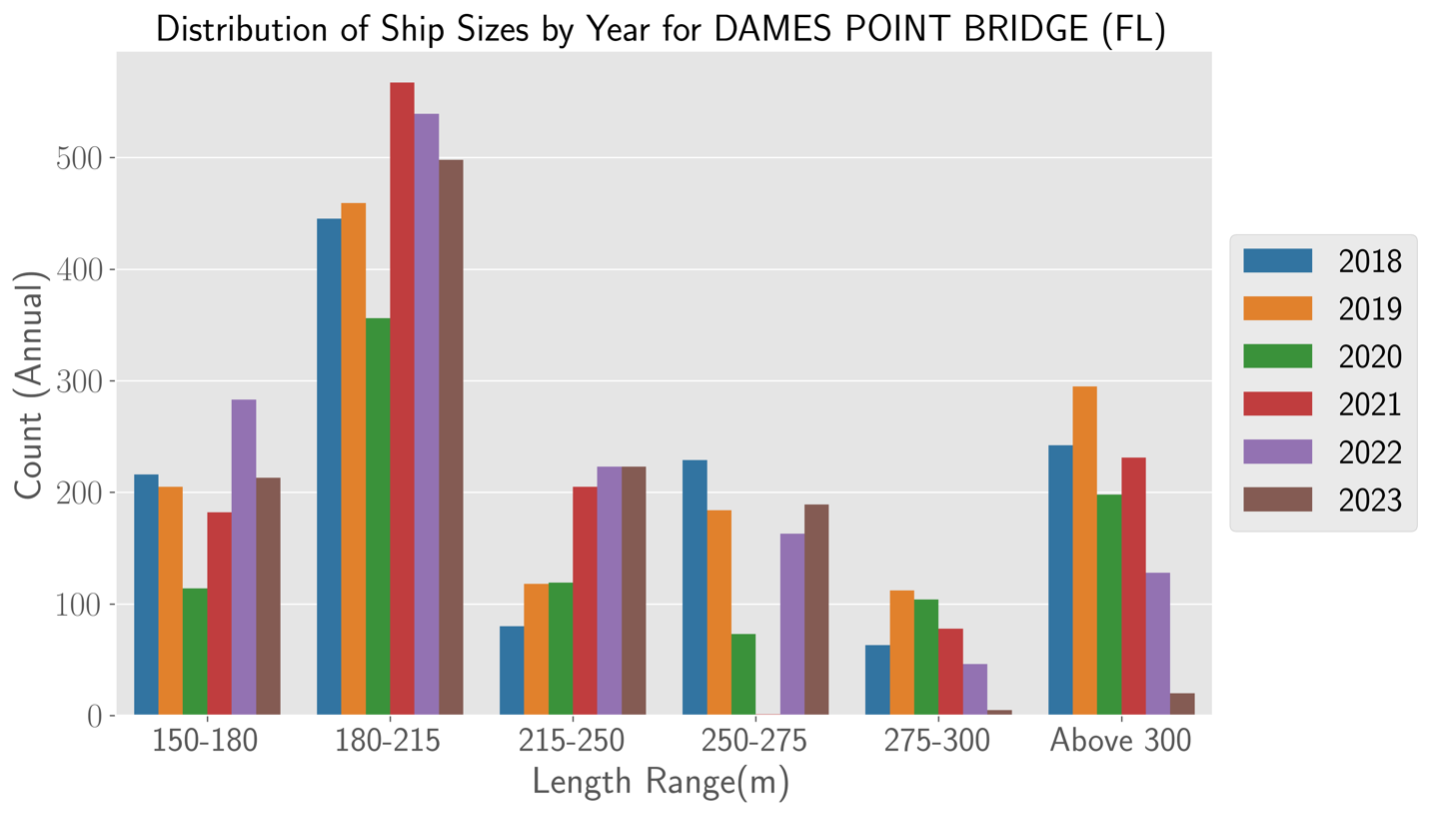
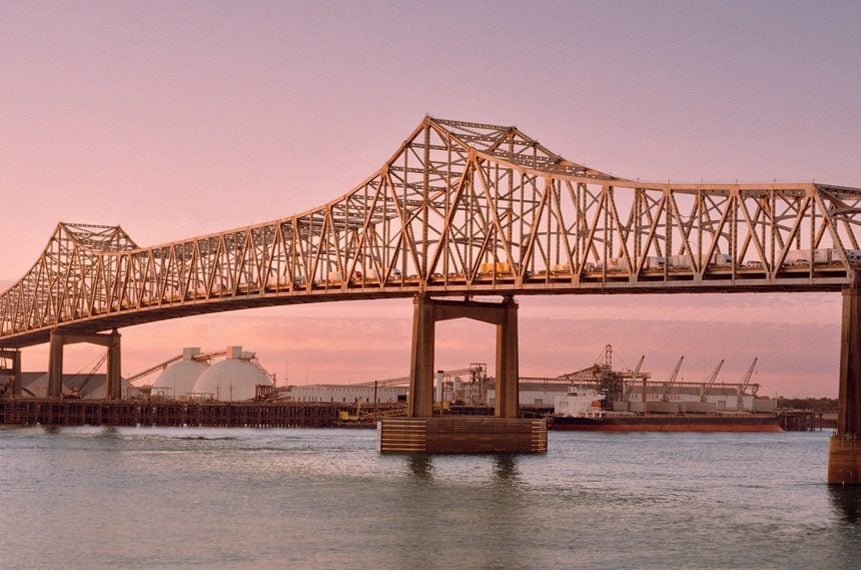
18
Horace Wilkinson Bridge (LA)
Estimated Return Period of Collision: 198 years
Estimated Annual Probability of Collision: 0.5%
Read More
The Horace Wilkinson Bridge is a three-span steel cantilever truss bridge spanning the Mississippi River at Baton Rouge, LA. It was completed in 1968. Its column bent piers are supported on caissons and protected by a precast concrete fender system that completed in 2007.
The bridge sees an average of 2-3 large ships per day, which ranks 32nd nationally in large ship traffic. However, it sees a relatively large number of the largest ships, ranking 11th nationally in mega ship traffic with approximately one mega ship every other day. The majority of traffic passes under the west span (between the west pier and the west bank), while some traffic passes under the east span (between the east pier and east bank). Very little traffic pass between the piers.
The bridge is expected to experience a major ship collision approximately once every 198 years.
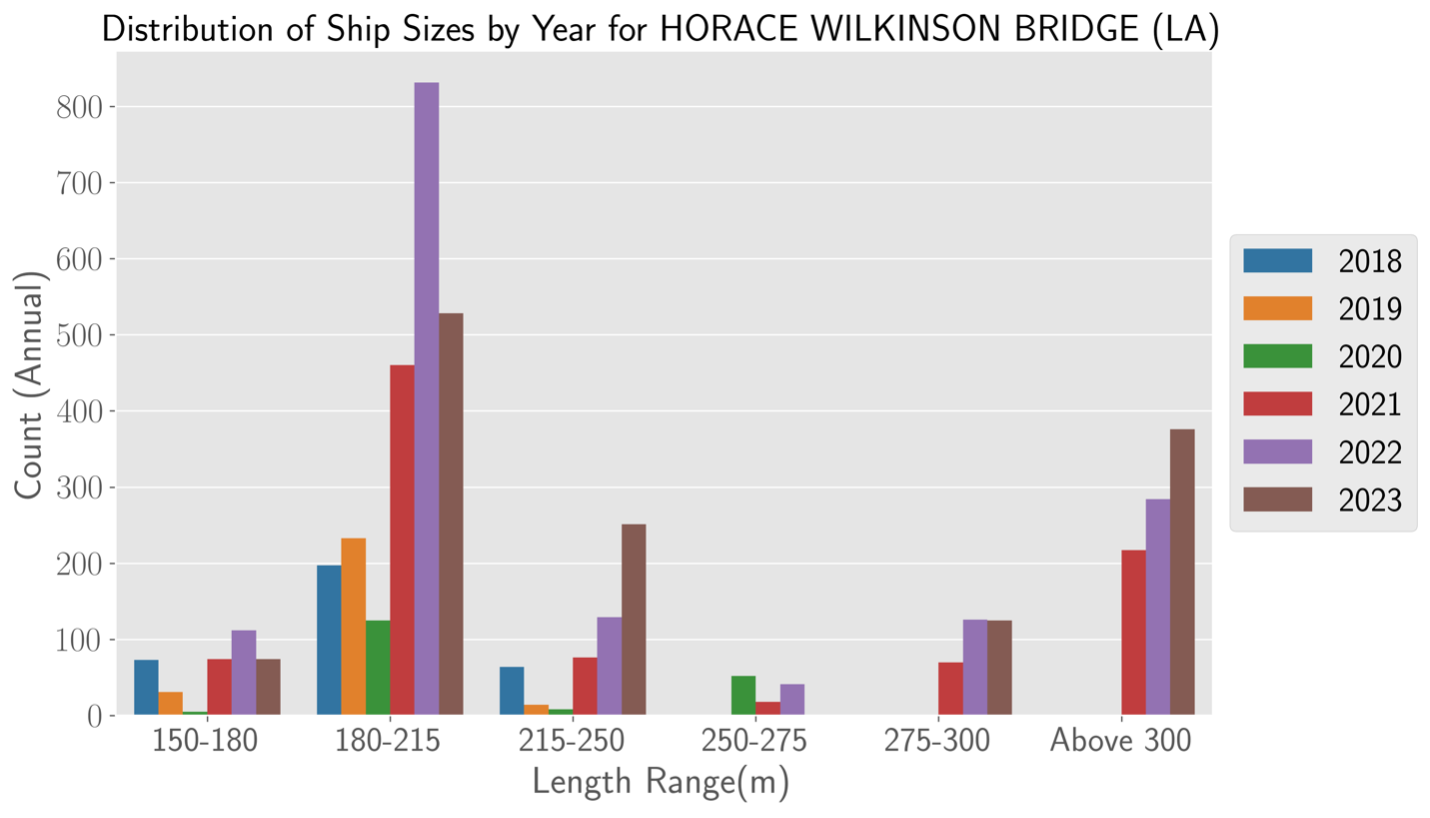
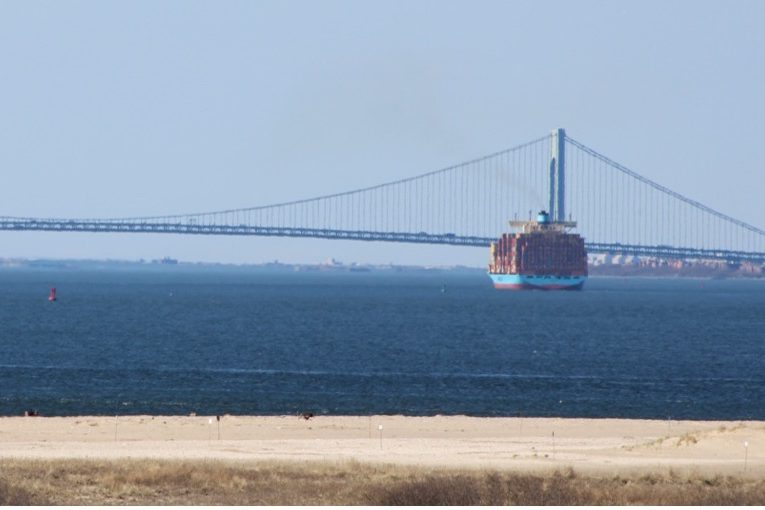
19
Verrazzano Narrows (NY)
Estimated Return Period of Collision: 362 years
Estimated Annual Probability of Collision: 0.3%
Read More
The Verrazzano Narrows Bridge spans the Narrows in New York City, between Staten Island and Brooklyn, that connects the Atlantic Ocean to the New York Harbor. Completed in 1964, the bridge is a suspension bridge with steel towers that are protected at their bases by rock islands. The pier dimensions for the geometry calculations were taken as the steel tower footprint above foundation and do not include the dimensions of the rock island.
The bridge is among the most heavily passed in the U.S. by large ships, ranking 3rd nationally in large ship traffic and is the most heavily trafficked bridge in the U.S. for mega ships with approximately 4-5 mega ships passing under its span each day. All traffic passes under the main span.
The bridge has a very long span between its piers (4,260 ft [1,298 m]) and its piers have some protection from rock islands around the base. It is expected to experience a major ship collision approximately once every 362 years.
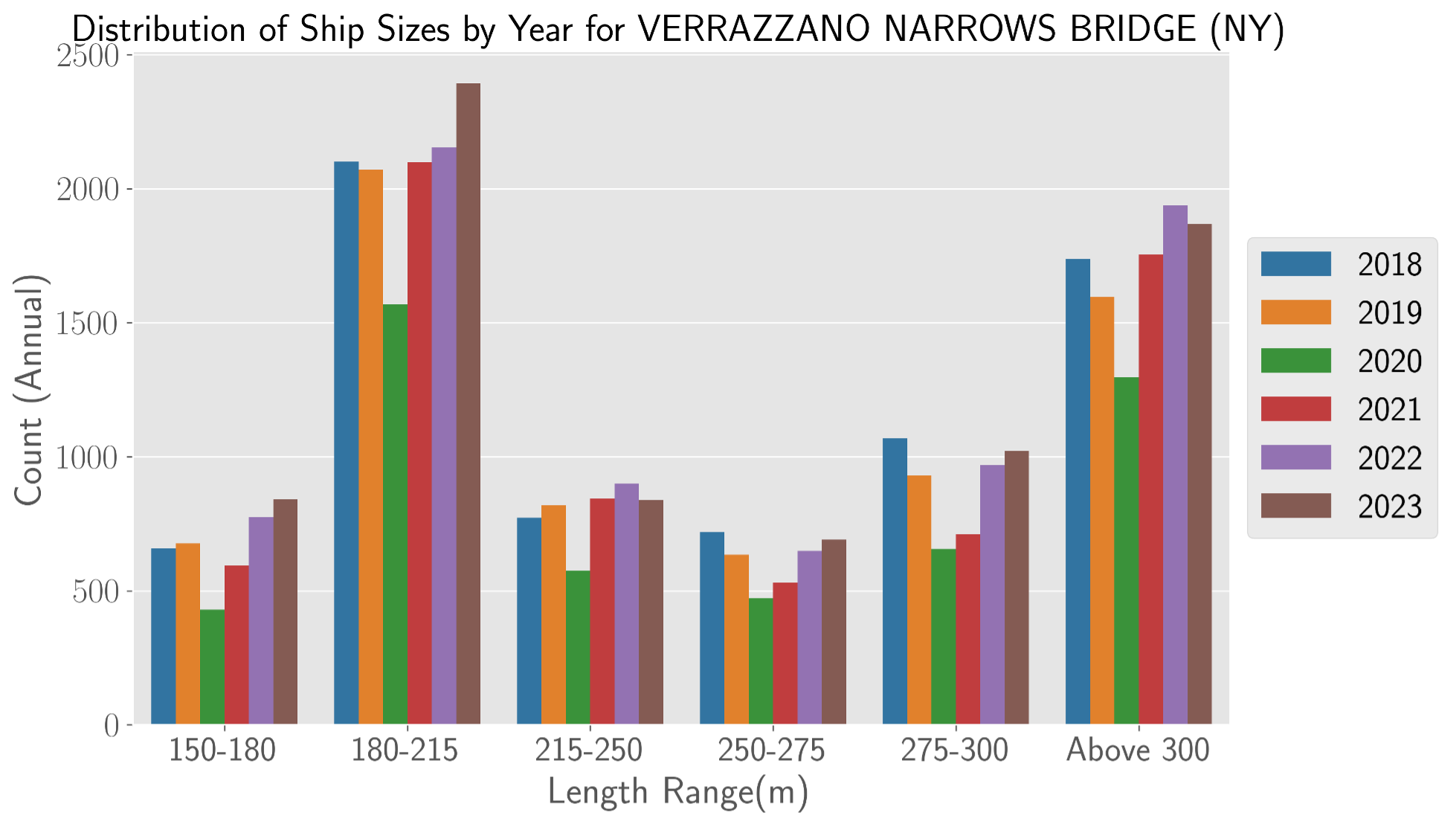
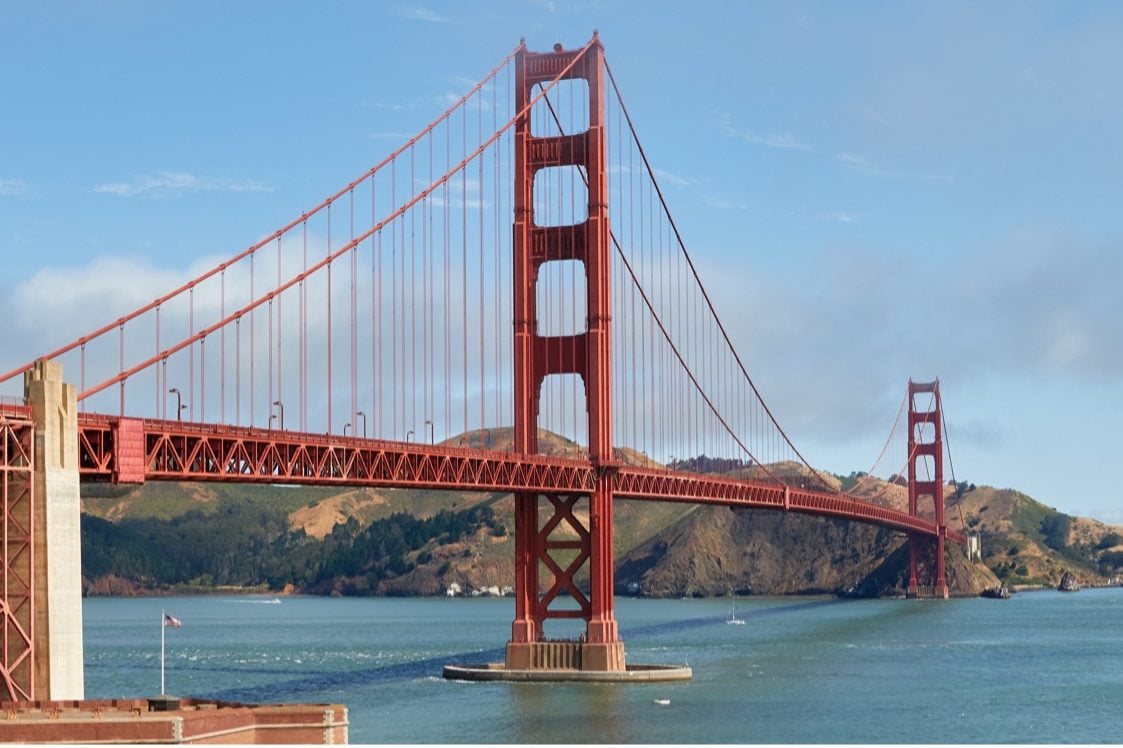
20
Golden Gate Bridge (CA)
Estimated Return Period of Collision: 481 years
Estimated Annual Probability of Collision: 0.2%
Read More
The Golden Gate Bridge spans the Golden Gate, the waterway just north of San Francisco, CA, that connects the Pacific Ocean to the San Francisco Bay. Completed in 1937, the bridge is a suspension form with steel towers that are protected at their bases by the foundations which include 8.4m thick concrete fenders. The pier dimensions for the geometry factor calculations were taken as the steel tower footprint above the foundation and do not include the dimensions of the fenders.
The bridge sees an average of 12-13 large ships per day, which ranks 7th nationally in large ship traffic. It also sees a large number of the largest ships, ranking 3rd nationally in mega ship traffic with approximately 2.3 mega ships passing every day. All traffic passes North of the pier in the middle of the waterway.
The bridge has a very long span between its piers (4,200 ft) and its piers have some protective fenders around the base. It is expected to experience a major ship collision approximately once every 481 years.
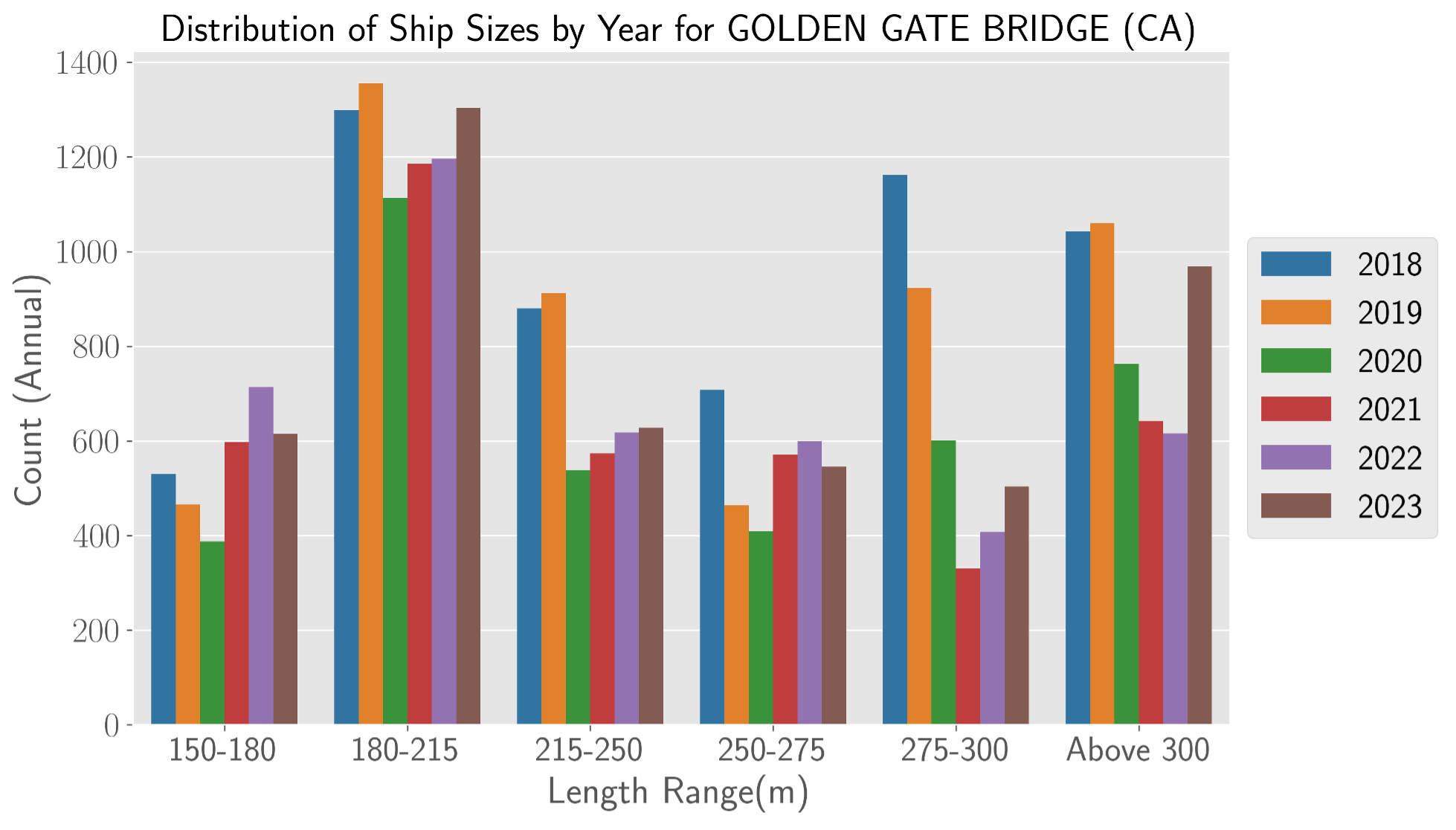
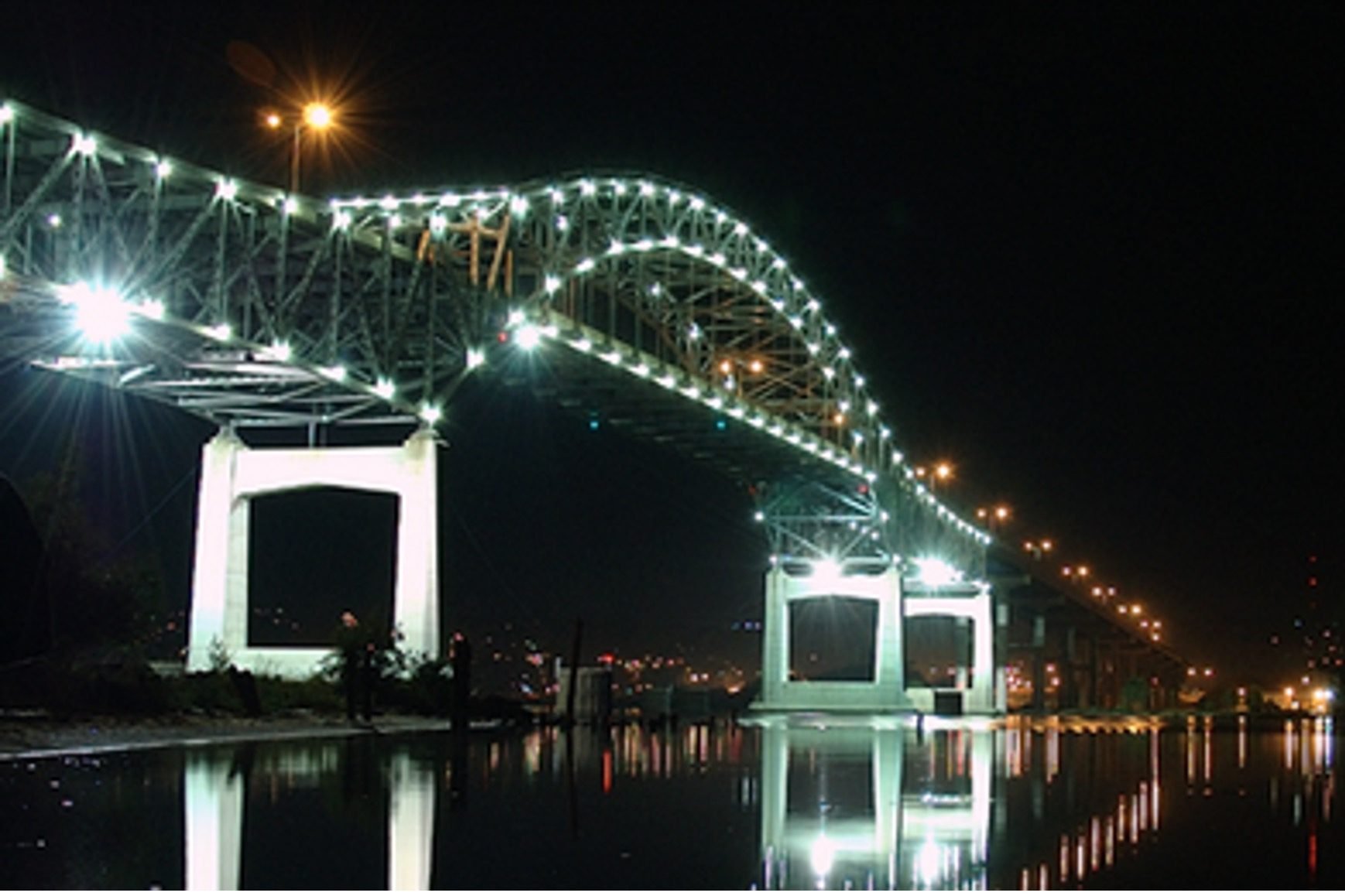
21
John A. Blatnik Bridge (MN-WI)
Estimated Return Period of Collision: 634 years
Estimated Annual Probability of Collision: 0.2%
Read More
The John A. Blatnik Bridge is a three-span continuous steel truss bridge (similar to the Francis Scott Key Bridge) with reinforced concrete column bent piers protected by dolphins (three dolphins per pier). The Blatnik Bridge foundations are visible above water but are not included in the pier measurements, which are taken to be only the out-to-out distances of the columns. There are two additional piers, one on either side of the three-span truss, supporting the approach spans. Those piers were assumed to be outside of the channel and not considered in these calculations. The Blatnik Bridge is due to be replaced in the next 5 years.
Although it sees comparatively few large ships, averaging only 1-2 large ships per day, which ranks 47th nationally in large ship traffic, it sees a relatively large proportion of extremely large ships with approximately one passing every other day. Effectively all traffic passes under the central span.
The bridge is expected to experience a major ship collision approximately once every 634 years.
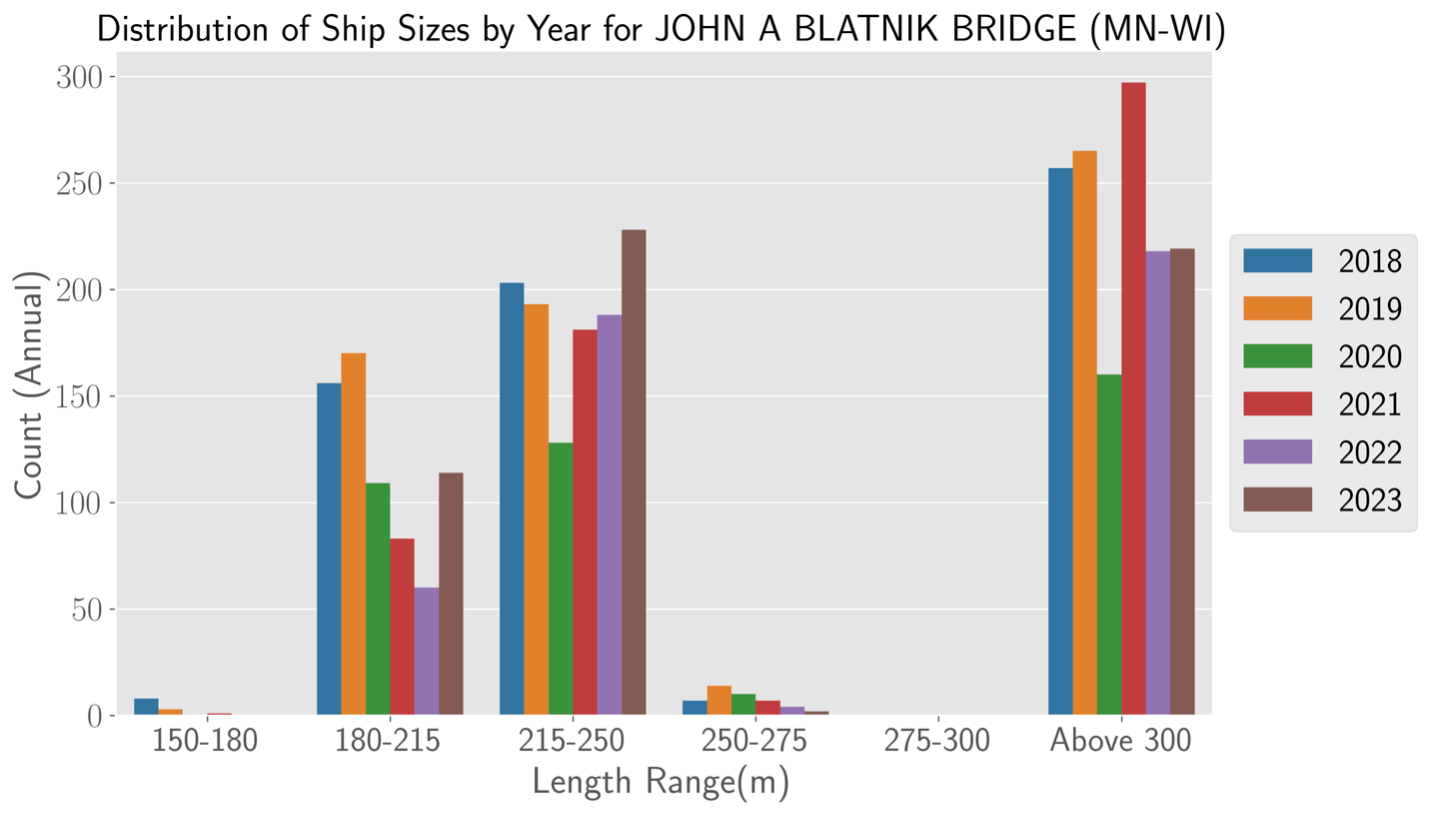
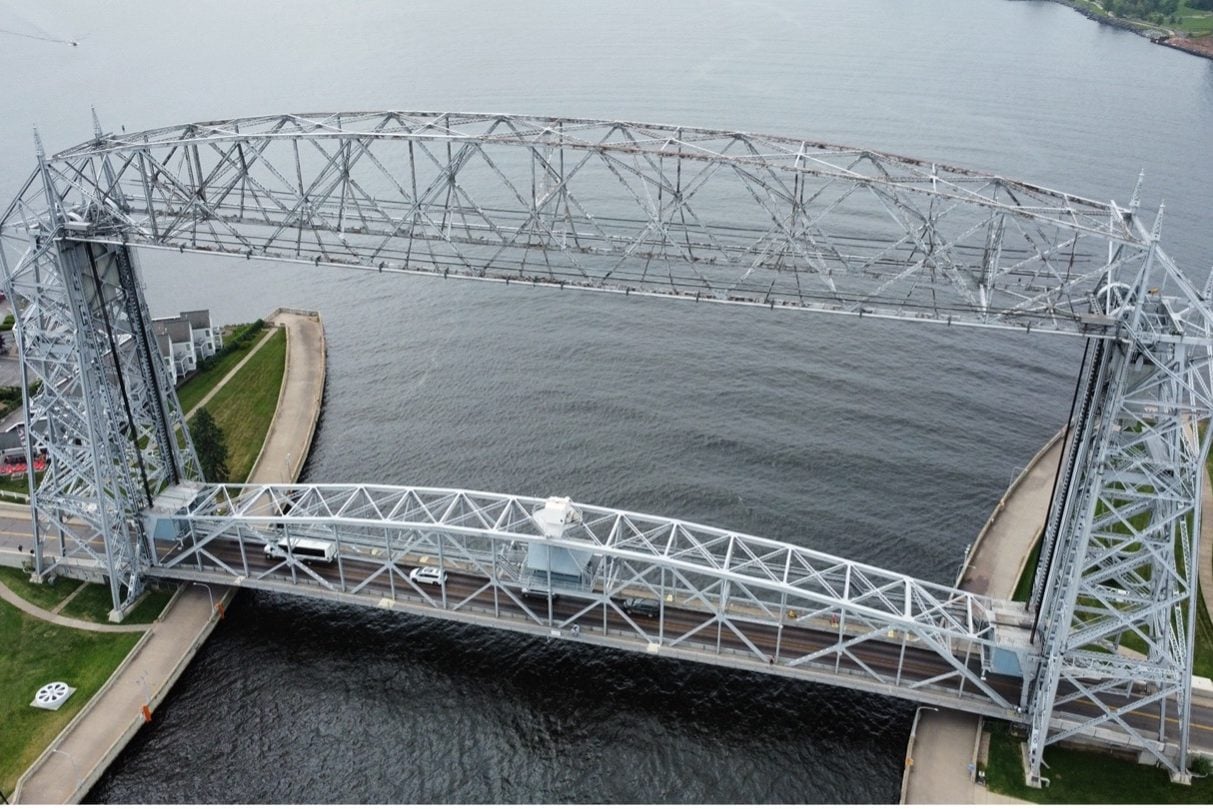
22
Duluth Aerial Lift Bridge (MN)
Estimated Return Period of Collision: N/A
Estimated Annual Probability of Collision: 0.0%
Read More
The Duluth Aerial Lift Bridge is a single-span steel truss lift bridge with steel truss supports (abutments) on land. Though it sees substantial very large vessel traffic, ranking 8th nationally in mega ship traffic, it was not considered in the collision calculations due to its lack of piers in the waterway
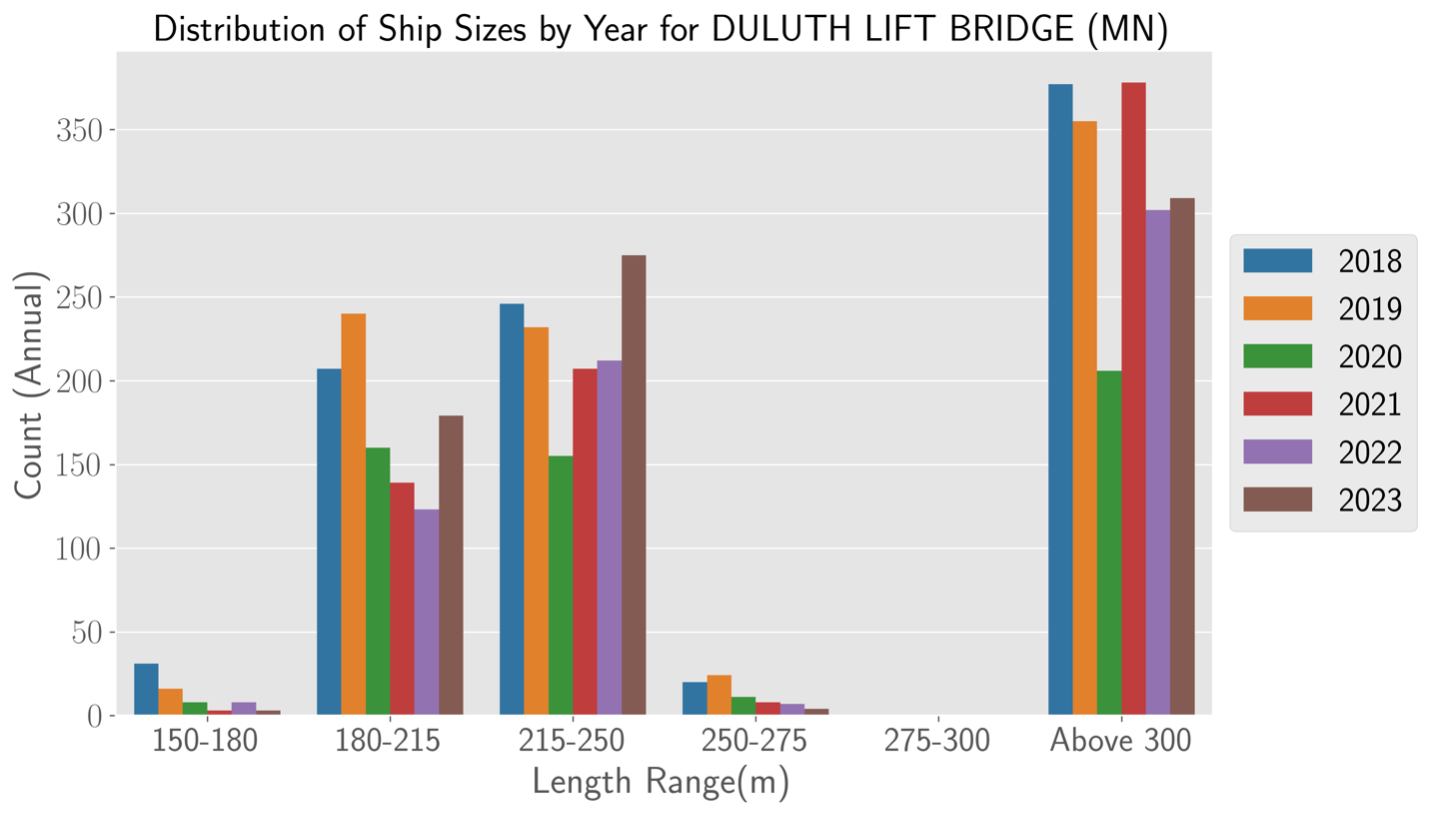
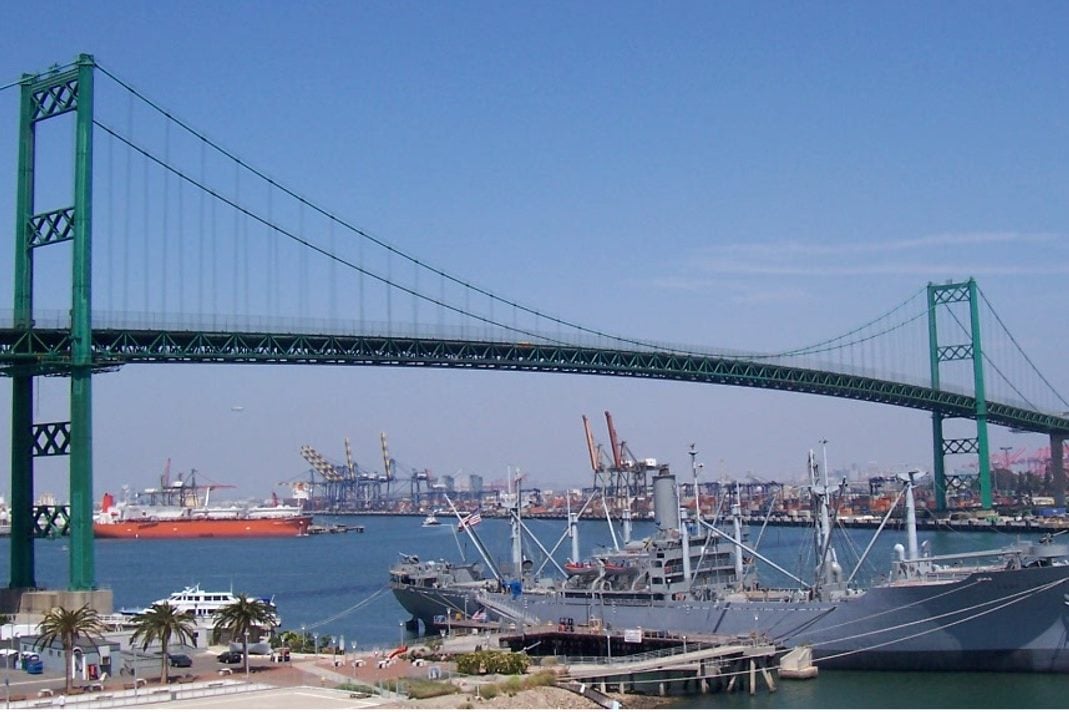
23
Vincent Thomas Bridge (CA)
Estimated Return Period of Collision: N/A
Estimated Annual Probability of Collision: 0.0%
Read More
The Vincent Thomas Bridge is a steel suspension bridge that carries State Route 47 over the Los Angeles Channel in Los Angeles, CA. The bridge was built in 1963 and its suspension bridge towers are both entirely on land. As a result, we did not calculate the probability of ship collision for this bridge, even though it sees a lot of large vessel traffic.
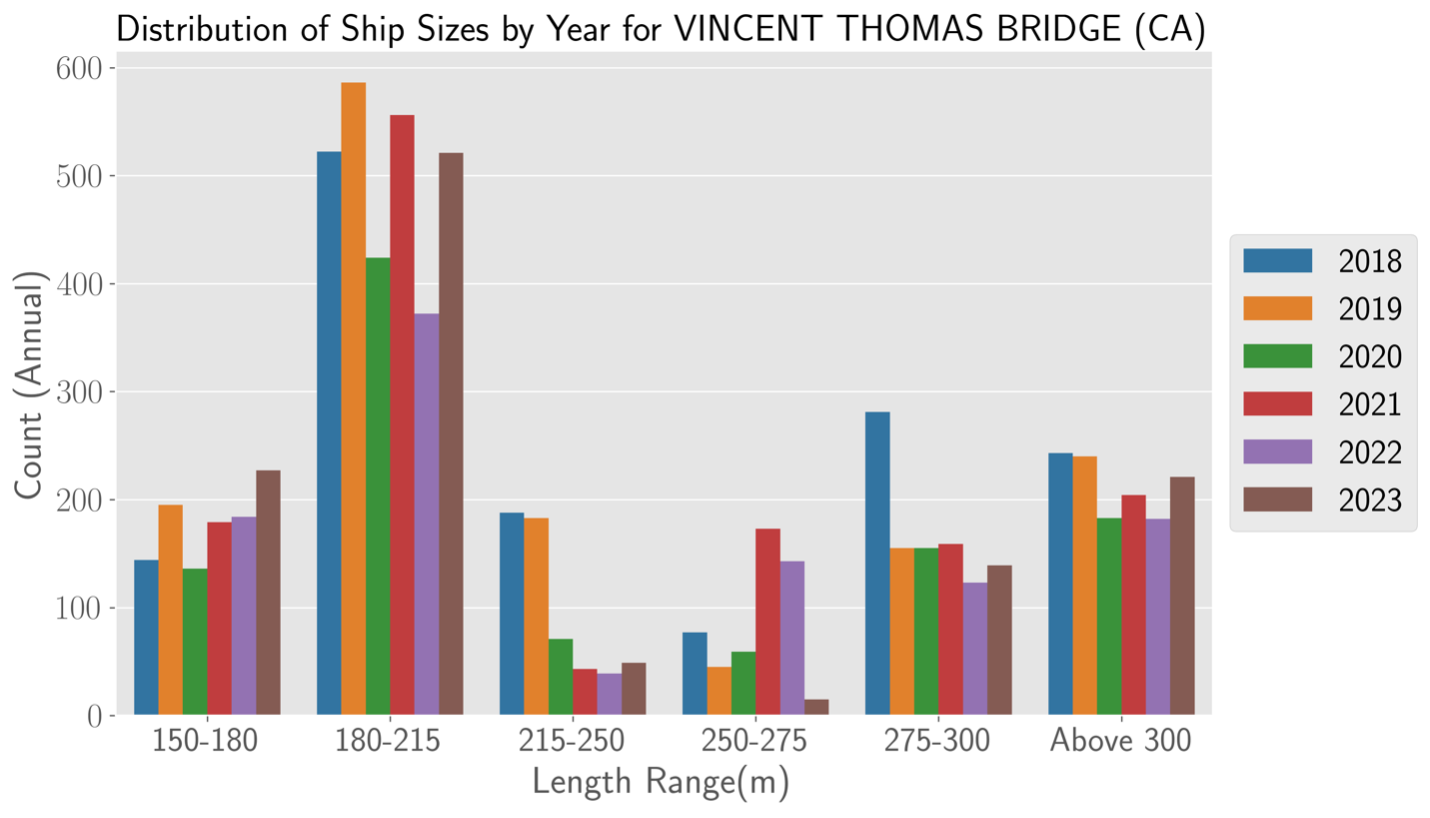
Image attributions can be found here.

